Seems like you've found quite a few habitable world nearby, and thankfully few hostile aliens. I'm looking forward to the Lombards finding their first alien empire.
The Light-Speed Lombards
- Thread starter RedTemplar
- Start date
-
We have updated our Community Code of Conduct. Please read through the new rules for the forum that are an integral part of Paradox Interactive’s User Agreement.
You are using an out of date browser. It may not display this or other websites correctly.
You should upgrade or use an alternative browser.
You should upgrade or use an alternative browser.
Colonies and Corvettes
2210 - 2220 AD: New Homes and New Threats
A Home Among the Stars
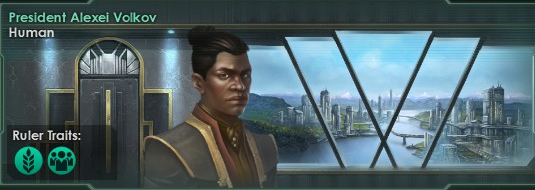
Alexei Volkov, inventor of the deflector shield, elected as ENC President in 2210 AD.
In the election of 2210 AD, the UN General Assembly replaced President Stavros Nikolaidis as the head of the Earth Naval Coalition. In his place, they chose the Russian Alexei Volkov, formerly the ENC's Chief Physicist and the inventor of the first functional deflector shields. Volkov's involvement in the ENC's space program meant that he had many political allies, but his campaign also gained him great public favor because of his policy of aggressive interstellar expansion. While Nikolaidis urged caution and restraint, Volkov promised that his term as President would be marked by the first human colony in space. The people of Earth bought in wholeheartedly, and the assembly elected him in a landslide.
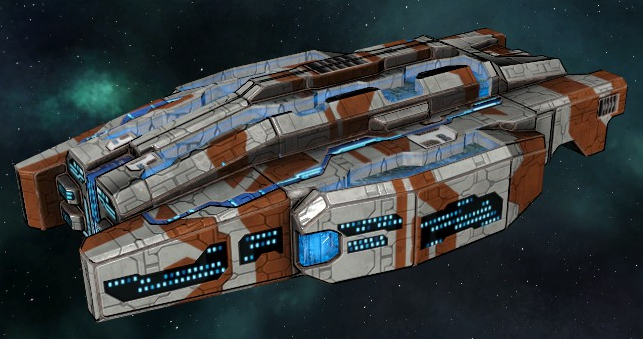
The Frontier-class colony ship, developed in 2212 AD.
At Volkov's direction, the ENC designed the Frontier-class colony ship -- a massive vessel that could carry colonial settlers by the thousands, and could be converted into a base of operations for the settling of a new world. The first Frontier-class vessel, the CCS (Coalition Colony Ship) New Horizon was deployed in 2212, two years after Volkov took office.
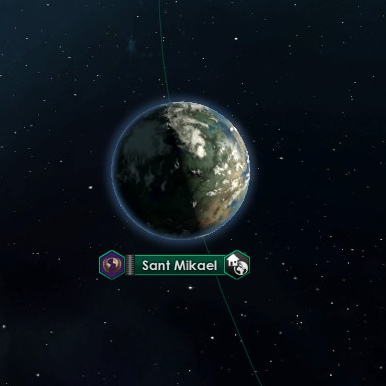
Sant Mikael (Alpha Centauri II), the first human colony.
Full of eager passengers clamoring to become the first humans to settle in outer space, the New Horizon made landfall on Alpha Centauri II on August 11, 2213. The planet was named Sant Mikael, in honor of the researcher responsible for the discovery of the first habitable planets outside of earth.
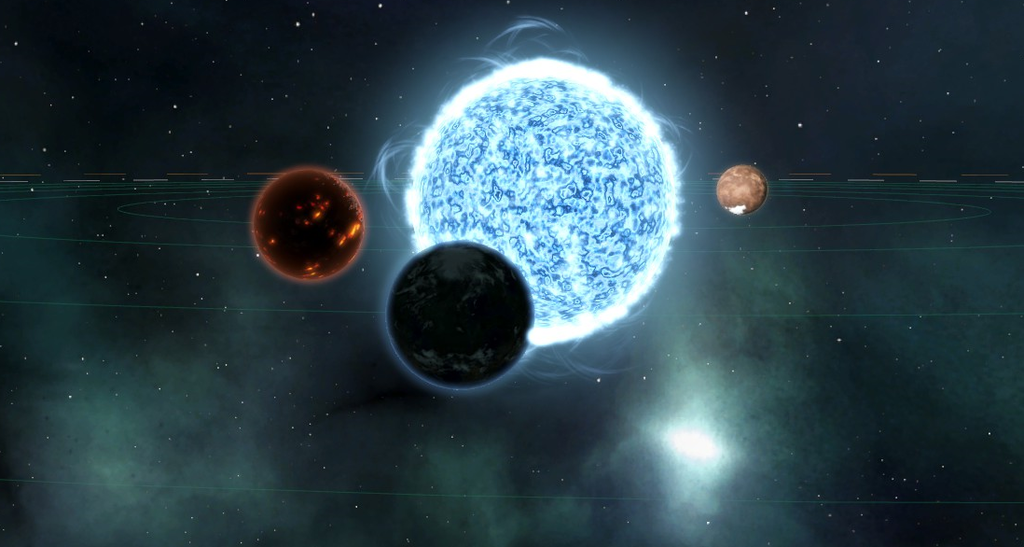
Concord (Sirius III), settled after the success of the Sant Mikael colony.
As the colonial venture into Alpha Centauri was well received, within a few years a second was organized -- this time, the CCS Prosperity traveled to Sirius III, which was settled as Concord. Mankind now had two colonies in foreign star systems in less than a decade. As the settlers laid down their roots and more humans began to migrate from Earth to these new colonies, both began to take shape and begin developing into slowly-prospering new frontier worlds. It would still be many years until they would reach full efficiency, but they marked a historic step forward for humanity.
Lifeforms in the Void
When the ENC Expedition began, hopes were high that it would lead to the discovery of other intelligent civilizations somewhere out in another star system. The opening years of the Expedition disappointed in that area. The only traces of life were the gas-grazing "Tiyanki," and any indications of intelligent life were of presumably extinct civilizations -- such as the Vultaum Star Assembly, or the extinct civilization memorialized on Ganymede.
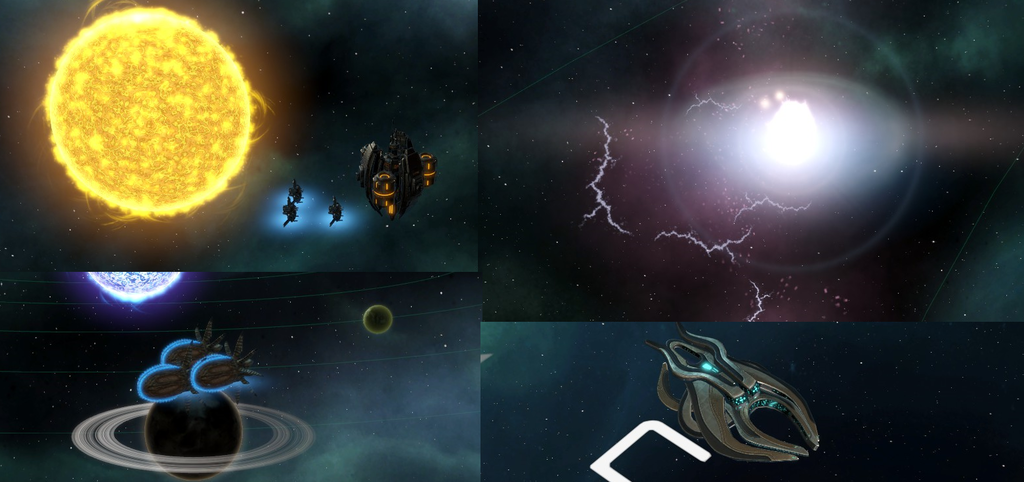
First Contact sightings made from 2208 - 2212 AD.
Within the years immediately prior and immediately following President Volkov's election, multiple contacts were made by the ENC's research vessels. The Coalition maintained its policy of nonviolent First Contact, studying the encountered species from afar in order to determine their nature. The first three were easy to study, as they remained relatively static. The first was an AI-controlled mining station guarded by several automated drones; the second, a mysterious "void cloud" giving off some form of energy impulses; the third, a flock of "Space Amoebas" orbiting a gas giant; the fourth, an advanced starship who left the system before proper contact was established.
The discovery of these lifeforms touched off a storm of debate in the ENC and the United Nations. The most radical proposed a policy of complete isolationism, leaving the creatures to themselves. Many more moderate voices sought to find some way to contain or further study them. The voices that spoke the loudest, however, were the wealthiest -- the likes of Byzantium and the wealthy American states. The systems inhabited by these species could not be safely exploited and built in until their presence was dealt with. And so, against his wishes but under intense political pressure, President Volkov ordered the first mobilization of the ENC's warfleet.
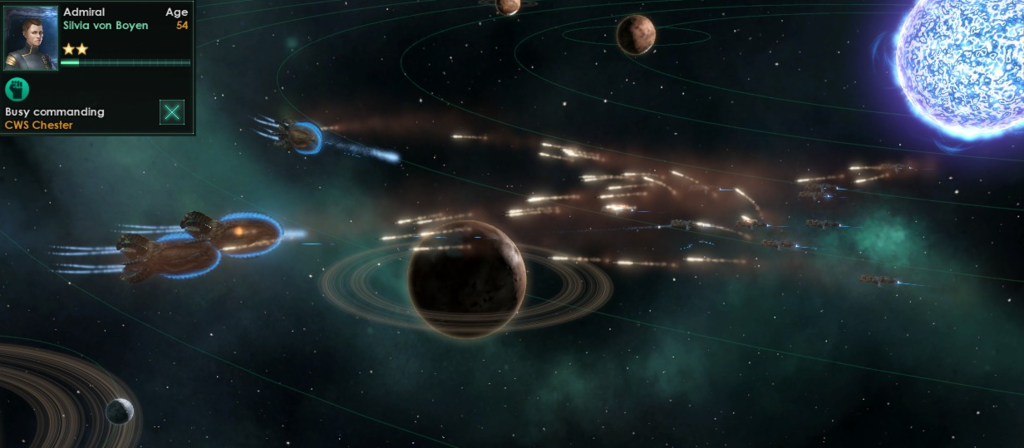
In the first test of its military capabilities, the ENC fleet engages a trio of wandering Space Amoebas.
Fleet Admiral Silvia von Boyen was the commander of Lombardia's long-legendary terrestrial navy. The Lombards had been known for naval dominance since the 1600's, as their navy frequently clashed with great powers like the Byzantine Empire, Spain, France, and Great Britain, and won decisive naval victories in each. Admiral von Boyen was chosen for her expertise in fleet warfare and appointed as the first acting Admiral of the ENC combat fleet, sent to the Tiralam system to eliminate the Space Amoebas. The battle was somewhat protracted, as the creatures were several times larger than the ENC's Falcon-class corvettes and were quite durable. Several corvettes were destroyed during the battle, but the long-range nuclear missile bombardment coordinated by Admiral von Boyen overwhelmed the creatures, spelling their defeat.
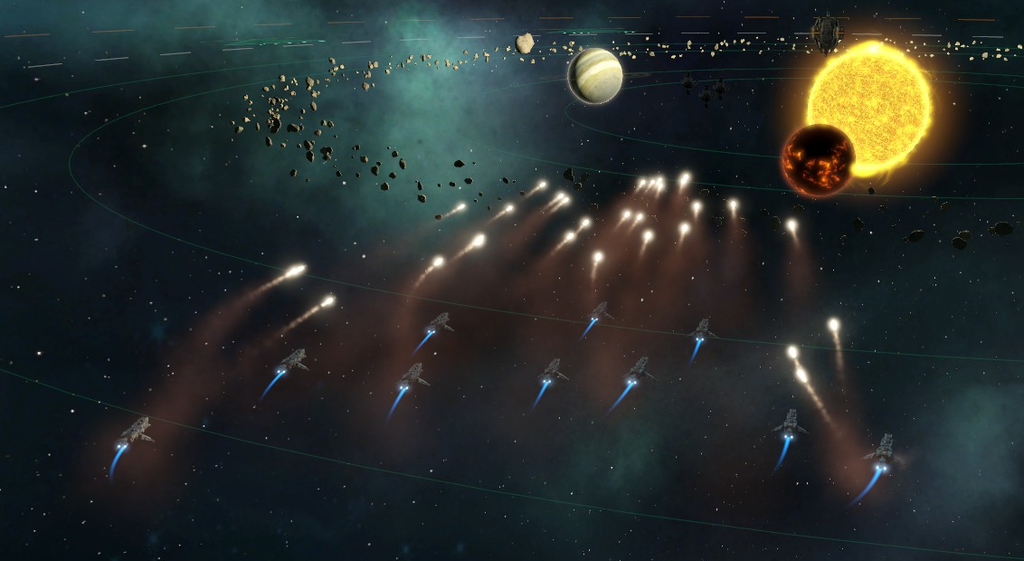
Admiral von Boyen's fleet destroys an abandoned AI mining station.
The mining drones in the Xarmaton system were a much easier matter. In t heir small numbers, they were easily defeated by the ENC fleet, which then went on to destroy the armored mining station from which the drones had operated. The wreckage of the drones proved particularly useful -- scientists were able to reverse-engineer their mining equipment to produce a military-grade mining laser designed to penetrate heavy ship armor, which would be incorporated into several hypothetical starship and station designs.
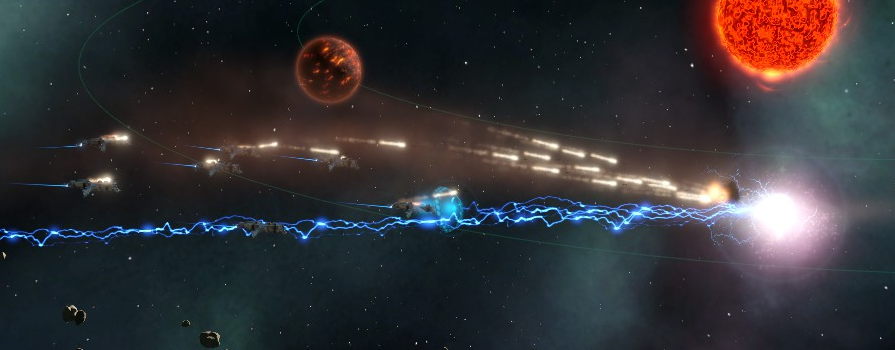
A strange Void Cloud is defeated by the ENC Navy.
Finally, von Boyen's fleet engaged and dispersed the mysterious Void Cloud, which fought back using strange electrical impulses that struck the ENC ships with daunting accuracy. Despite this, the deflector shields on the Coalition corvettes held, and a third battle was won by the Admiral and her fleet. The victories were well-received on Earth; governments and companies could now freely look into exploiting the resources in these systems, and the civilian populous was reassured by the success of the ENC's navy in its first real combat experiences.
Still, these were Void Clouds and Space Amoebas -- far from the advanced space civilizations so many had hoped to find. However, those clamoring for contact with other civilizations would soon find their dreams realized, and in numbers.
Humanity was not at all alone.
2210 - 2220 AD: New Homes and New Threats
A Home Among the Stars

Alexei Volkov, inventor of the deflector shield, elected as ENC President in 2210 AD.
In the election of 2210 AD, the UN General Assembly replaced President Stavros Nikolaidis as the head of the Earth Naval Coalition. In his place, they chose the Russian Alexei Volkov, formerly the ENC's Chief Physicist and the inventor of the first functional deflector shields. Volkov's involvement in the ENC's space program meant that he had many political allies, but his campaign also gained him great public favor because of his policy of aggressive interstellar expansion. While Nikolaidis urged caution and restraint, Volkov promised that his term as President would be marked by the first human colony in space. The people of Earth bought in wholeheartedly, and the assembly elected him in a landslide.

The Frontier-class colony ship, developed in 2212 AD.
At Volkov's direction, the ENC designed the Frontier-class colony ship -- a massive vessel that could carry colonial settlers by the thousands, and could be converted into a base of operations for the settling of a new world. The first Frontier-class vessel, the CCS (Coalition Colony Ship) New Horizon was deployed in 2212, two years after Volkov took office.

Sant Mikael (Alpha Centauri II), the first human colony.
Full of eager passengers clamoring to become the first humans to settle in outer space, the New Horizon made landfall on Alpha Centauri II on August 11, 2213. The planet was named Sant Mikael, in honor of the researcher responsible for the discovery of the first habitable planets outside of earth.

Concord (Sirius III), settled after the success of the Sant Mikael colony.
As the colonial venture into Alpha Centauri was well received, within a few years a second was organized -- this time, the CCS Prosperity traveled to Sirius III, which was settled as Concord. Mankind now had two colonies in foreign star systems in less than a decade. As the settlers laid down their roots and more humans began to migrate from Earth to these new colonies, both began to take shape and begin developing into slowly-prospering new frontier worlds. It would still be many years until they would reach full efficiency, but they marked a historic step forward for humanity.
Lifeforms in the Void
When the ENC Expedition began, hopes were high that it would lead to the discovery of other intelligent civilizations somewhere out in another star system. The opening years of the Expedition disappointed in that area. The only traces of life were the gas-grazing "Tiyanki," and any indications of intelligent life were of presumably extinct civilizations -- such as the Vultaum Star Assembly, or the extinct civilization memorialized on Ganymede.

First Contact sightings made from 2208 - 2212 AD.
Within the years immediately prior and immediately following President Volkov's election, multiple contacts were made by the ENC's research vessels. The Coalition maintained its policy of nonviolent First Contact, studying the encountered species from afar in order to determine their nature. The first three were easy to study, as they remained relatively static. The first was an AI-controlled mining station guarded by several automated drones; the second, a mysterious "void cloud" giving off some form of energy impulses; the third, a flock of "Space Amoebas" orbiting a gas giant; the fourth, an advanced starship who left the system before proper contact was established.
The discovery of these lifeforms touched off a storm of debate in the ENC and the United Nations. The most radical proposed a policy of complete isolationism, leaving the creatures to themselves. Many more moderate voices sought to find some way to contain or further study them. The voices that spoke the loudest, however, were the wealthiest -- the likes of Byzantium and the wealthy American states. The systems inhabited by these species could not be safely exploited and built in until their presence was dealt with. And so, against his wishes but under intense political pressure, President Volkov ordered the first mobilization of the ENC's warfleet.

In the first test of its military capabilities, the ENC fleet engages a trio of wandering Space Amoebas.
Fleet Admiral Silvia von Boyen was the commander of Lombardia's long-legendary terrestrial navy. The Lombards had been known for naval dominance since the 1600's, as their navy frequently clashed with great powers like the Byzantine Empire, Spain, France, and Great Britain, and won decisive naval victories in each. Admiral von Boyen was chosen for her expertise in fleet warfare and appointed as the first acting Admiral of the ENC combat fleet, sent to the Tiralam system to eliminate the Space Amoebas. The battle was somewhat protracted, as the creatures were several times larger than the ENC's Falcon-class corvettes and were quite durable. Several corvettes were destroyed during the battle, but the long-range nuclear missile bombardment coordinated by Admiral von Boyen overwhelmed the creatures, spelling their defeat.

Admiral von Boyen's fleet destroys an abandoned AI mining station.
The mining drones in the Xarmaton system were a much easier matter. In t heir small numbers, they were easily defeated by the ENC fleet, which then went on to destroy the armored mining station from which the drones had operated. The wreckage of the drones proved particularly useful -- scientists were able to reverse-engineer their mining equipment to produce a military-grade mining laser designed to penetrate heavy ship armor, which would be incorporated into several hypothetical starship and station designs.

A strange Void Cloud is defeated by the ENC Navy.
Finally, von Boyen's fleet engaged and dispersed the mysterious Void Cloud, which fought back using strange electrical impulses that struck the ENC ships with daunting accuracy. Despite this, the deflector shields on the Coalition corvettes held, and a third battle was won by the Admiral and her fleet. The victories were well-received on Earth; governments and companies could now freely look into exploiting the resources in these systems, and the civilian populous was reassured by the success of the ENC's navy in its first real combat experiences.
Still, these were Void Clouds and Space Amoebas -- far from the advanced space civilizations so many had hoped to find. However, those clamoring for contact with other civilizations would soon find their dreams realized, and in numbers.
Humanity was not at all alone.
I like how you ran into a new species and your response was to wipe it out. Going "no! my space."
ENC Contact Briefing
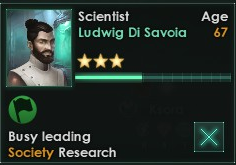
Summary Report on Sentient Species Encountered in Galactic Space
March 19, 2220 AD
Compiled for briefing of President Volkov and ENC Executive Council
By Dr. Ludwig Di Savoia, Chief of Social Research, ENC Headquarters
Introduction
At the request of ENC President Alexei Volkov, I have undertaken to compile a brief summary of the non-human extraterrestrial civilizations with which we have made contact over the course of the past decade. Since our first true contact with advanced, sentient, post-FTL societies, we have come to establish communication with four individual insterstellar civil bodies, all comprised of generally "Molluscoid" species. In order to inform the President and the Executive Council of our accumulated research, and to provide similar information to the United Nations General Assembly at its next meeting, I have put together the following brief dossiers on these contacts.
1. The Karabnar Star Polity
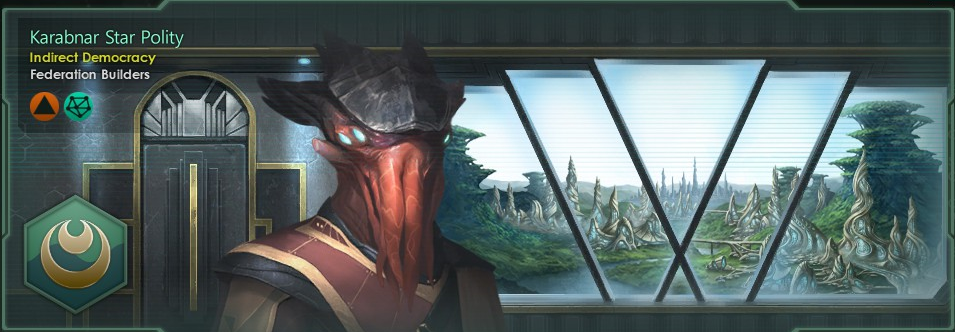
The Karabnar Star Polity was the first positive contact of advanced civilization made by the ENC, and were likewise the first to engage in economic and political dialogue with us. The Karabnar appear to prefer worlds with a tropical climate, similar to their homeworld, Karab. Our interaction with the Karabnar people have shown them to be exceptionally intelligent in almost every area; they are particularly gifted in the realm of physics, potentially placing them ahead of us in critical scientific discoveries. Their society is highly individualistic, even moreso than our own. The Karabnar Star Polity places the highest premium on liberty for the individual, and their government is run on democratic principles not unlike our own. They also appear to be very eager to establish contact with other species; they are very open in their desire to share knowledge and culture.
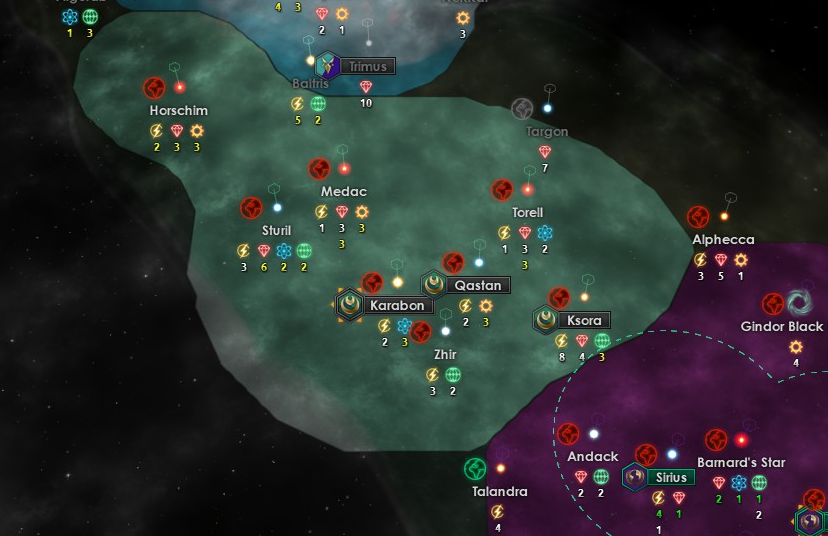
Their territory borders ours to the northwest, and contains a total of 8 star systems (around half the size of our own), but contains three inhabited worlds: the homeworld of Karab, and one colony each in the Qastan and Ksora systems. In this regard, they are on equal footing with our own three worlds. All three of their inhabited systems are to the south, nearest to our border; the stars to their north are used for resource collection.
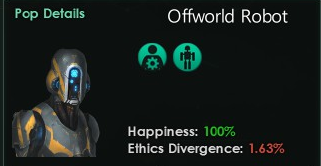
Interestingly, the Karabnar have employed robots with basic independent function to assist in the cultivation of their colony in the Qastan system. These do not appear to have any advanced cognitive function; they respond strictly to direct commands, but they are capable of inhabiting any conditions and are efficient workers for the production of raw resources. This is an avenue of study I recommend we might pursue -- such methods would permit us to colonize other planets in our own Sol system, for instance.
Based on their xenophilic attitude and their desire to build positive relationships with other civilizations, I do not believe we have any reason to see the Karabnar as a threat. I am aware that there is currently a proposal to grant immigration rights to KSP citizens; based upon my observation, I would not object to this initiative.
2. The Hathgum Hierarchy
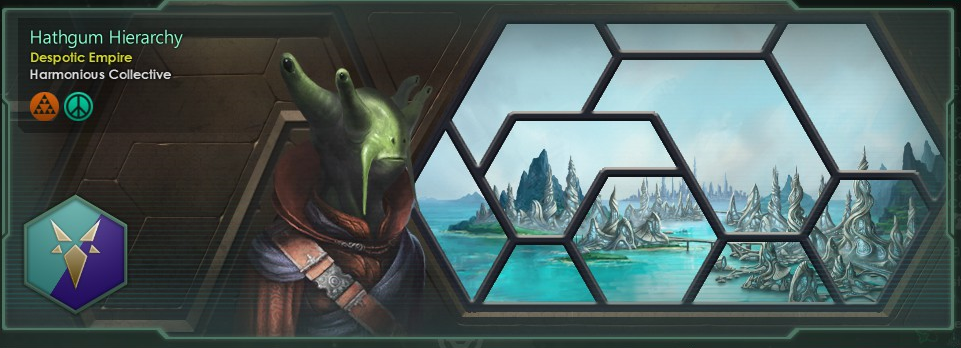
The Hathgum Hierarchy borders the Karabnar Star Polity to the north, extending close to the end of the galaxy's arm. In many ways, their characteristics are quite the opposite of our first contacts. These Molluscoids, who prefer oceanic worlds with minimal surface area, demonstrate exceptional physiological resilience. Not only are they believed to have extended lifespans, but they are physically durable and appear well-suited to direct combat. Despite this, the Hierarchy has adopted a pacifist ethic, and prefers to avoid armed conflict when possible. In contrast to the rugged individualism of the Karabnar, the Hathgum are radically collectivist in their attitude; individuality is hardly a concept in Hathgum society, favoring subordination to the cause of the state and species. The leader of the Hierarchy rules as an absolute dictator, but their preference seems to be to remain somewhat aloof from interaction with other species. I understand that all of our diplomatic interaction with them was rather bluntly shunned.
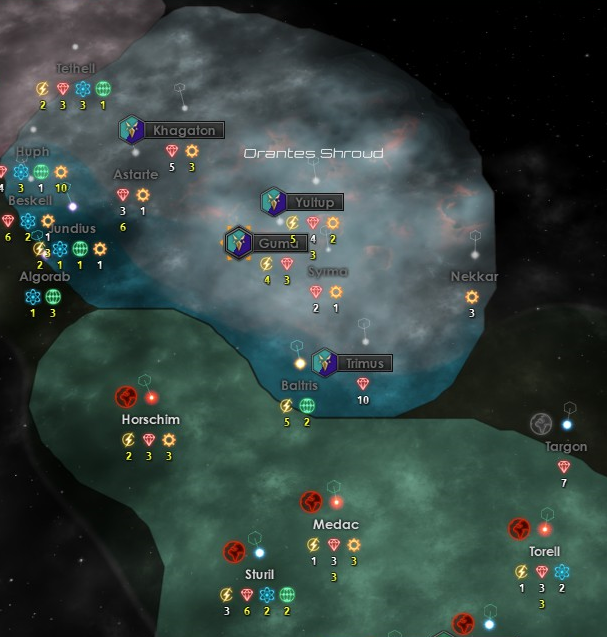
The Hierarchy's borders contain ten stars, making them slightly larger than the Karabnar Star Polity -- I should note, by the way, that those two states consider one another as rivals. Due to the reserved and isolationist nature of the Hathgum, we know very little about their colonized space. We are aware that their homeworld is called Hathguma, and that they possess four colonies in two star systems; this makes them the most thoroughly colonized race we have encountered to this point.
I believe, at this point, that the Hathgum are devoted enough to their isolated, collectivist society that it is unlikely they would engage in aggressive military action. Their rivalry with the Karabnar is somewhat troubling, however; if hostilities grow between those two, we could find ourselves very close to a galactic war.
3. The United Mathin Planet-States
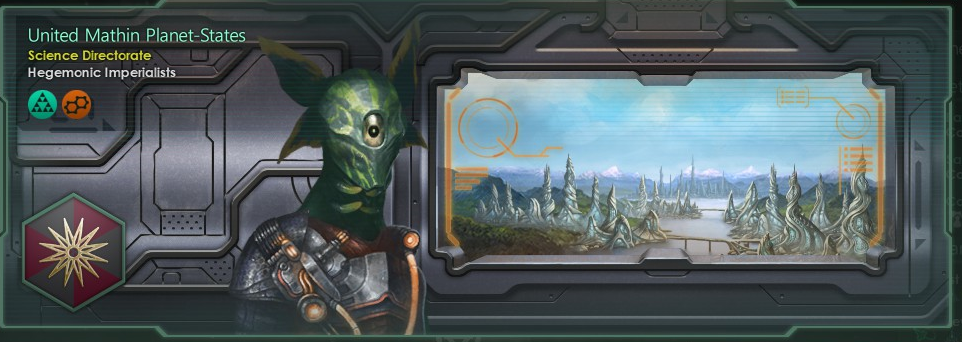
Preferring continental-type worlds of a similar type to our own, the Mathin are a particularly violent and physically resilient people whose outward attitude seems to reflect a desire for forceful expansion and domination. Their government is based on academic and scientific priorities, and they are governed by a small group of elite scholars who order their society and direct their people. They are not as radical as the Hathgum, but they seem to have a collectivist attitude to a certain degree, and they value hard science above all else.
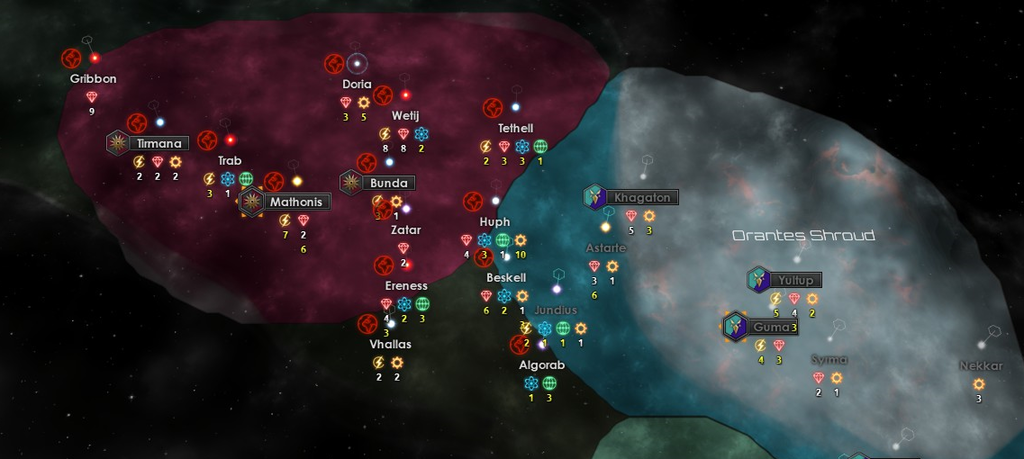
Their directorate encompasses ten star systems like their neighbors the Hathgum, and they have colonized three additional planets in two systems. At this time, the UMPS is the farthest-north of all civilizations we have encountered, and may be the last independent realm before this arm of the galaxy reaches its endpoint. In terms of interaction, the Mathin are difficult to read. Their attitude speaks of a desire for conquest and domination, but they have been at least partially receptive to our diplomatic overtures. They accepted our request to establish a Human embassy on their homeworld, and we are aware that they have an embassy of their own dealing with the Hathgum Hierarchy. Further, they did accept our offer to exchange star charts.
I believe that we ought to regard the Mathin with some degree of caution -- we have the Hathgum and Karabnar as a "buffer" in the event that they reveal themselves to be hostile, but I have reason to believe we will see them at war sooner rather than later.
4. The Uri Dominion
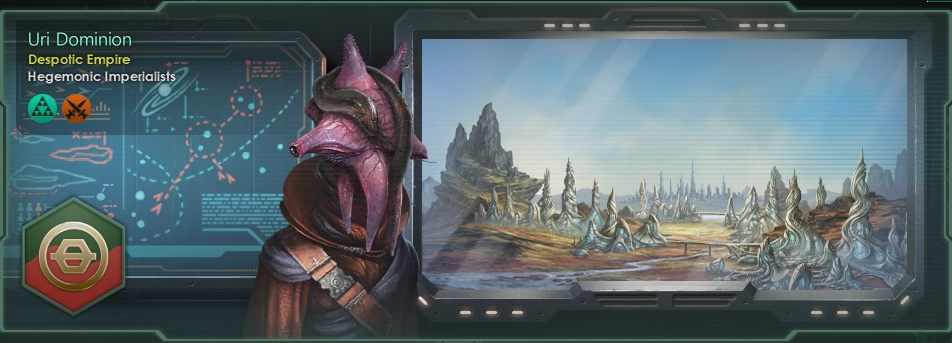
The Uri are a most unsettling race, Molluscoids favoring arid worlds with dry climates. They are noted to be fiercely competitive, and see both combat and other contests of skill as integral to their society and racial personality. Hunter-gatherers with a long tradition of martial prowess, they are ruled by a single absolute Emperor with unlimited power. Their society, like others, seems to have a slight collectivist slant, and the Emperor's power seems to be rarely questioned or contested in Uri society. They are very militaristic, as evidenced by their recent declaration of war -- although they have chosen to attack another unknown star empire with which we have not yet made contact.
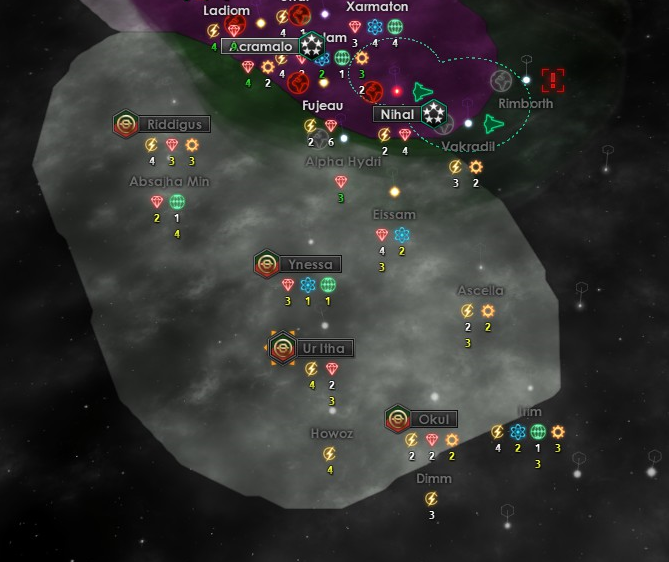
The Uri border us to the south, and contains nine star systems -- the contested Alpha Hydri system is controlled by us, but remains a point of contention between our realms. We are aware of three colonies in addition to the Uri homeworld. The Uri have been very outwardly unfriendly towards us, and I fear that we ought to begin preparing ourselves for an inevitable armed conflict.
It is my recommendation that we take measures to study their technology and prepare our ships accordingly; I would also strongly recommend the construction of fortified defensive stations around our key strategic systems in order to protect our most vital assets. I fear that war with the Uri Dominion is something we likely will not avoid.
Conclusion
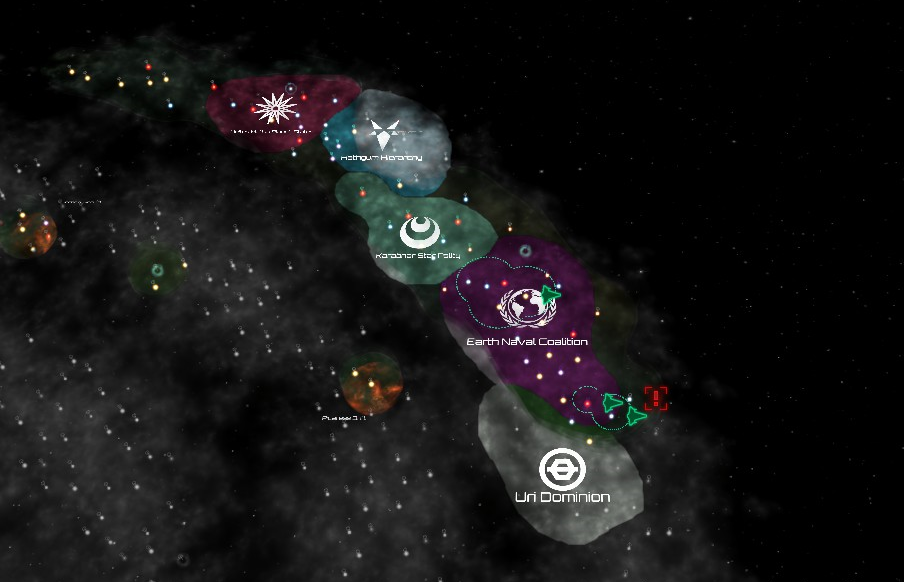
Of the species and civilizations we have encountered thus far, I believe that only the Karabnar Star Polity shows any true promise for cooperation. The Uri Dominion will almost definitely come to contest Alpha Hydri, the Hathgum are generally disinterested, and the Mathin may prove almost as ambitious as the Uri. It is my recommendation that we seek a positive relationship of cooperation, non-aggression, and defense as promptly as possible.
We are by no means in immediate danger, but I do find myself somewhat worried by the lack of friendly parties in this region of space.

Summary Report on Sentient Species Encountered in Galactic Space
March 19, 2220 AD
Compiled for briefing of President Volkov and ENC Executive Council
By Dr. Ludwig Di Savoia, Chief of Social Research, ENC Headquarters
Introduction
At the request of ENC President Alexei Volkov, I have undertaken to compile a brief summary of the non-human extraterrestrial civilizations with which we have made contact over the course of the past decade. Since our first true contact with advanced, sentient, post-FTL societies, we have come to establish communication with four individual insterstellar civil bodies, all comprised of generally "Molluscoid" species. In order to inform the President and the Executive Council of our accumulated research, and to provide similar information to the United Nations General Assembly at its next meeting, I have put together the following brief dossiers on these contacts.
1. The Karabnar Star Polity

The Karabnar Star Polity was the first positive contact of advanced civilization made by the ENC, and were likewise the first to engage in economic and political dialogue with us. The Karabnar appear to prefer worlds with a tropical climate, similar to their homeworld, Karab. Our interaction with the Karabnar people have shown them to be exceptionally intelligent in almost every area; they are particularly gifted in the realm of physics, potentially placing them ahead of us in critical scientific discoveries. Their society is highly individualistic, even moreso than our own. The Karabnar Star Polity places the highest premium on liberty for the individual, and their government is run on democratic principles not unlike our own. They also appear to be very eager to establish contact with other species; they are very open in their desire to share knowledge and culture.

Their territory borders ours to the northwest, and contains a total of 8 star systems (around half the size of our own), but contains three inhabited worlds: the homeworld of Karab, and one colony each in the Qastan and Ksora systems. In this regard, they are on equal footing with our own three worlds. All three of their inhabited systems are to the south, nearest to our border; the stars to their north are used for resource collection.

Interestingly, the Karabnar have employed robots with basic independent function to assist in the cultivation of their colony in the Qastan system. These do not appear to have any advanced cognitive function; they respond strictly to direct commands, but they are capable of inhabiting any conditions and are efficient workers for the production of raw resources. This is an avenue of study I recommend we might pursue -- such methods would permit us to colonize other planets in our own Sol system, for instance.
Based on their xenophilic attitude and their desire to build positive relationships with other civilizations, I do not believe we have any reason to see the Karabnar as a threat. I am aware that there is currently a proposal to grant immigration rights to KSP citizens; based upon my observation, I would not object to this initiative.
2. The Hathgum Hierarchy

The Hathgum Hierarchy borders the Karabnar Star Polity to the north, extending close to the end of the galaxy's arm. In many ways, their characteristics are quite the opposite of our first contacts. These Molluscoids, who prefer oceanic worlds with minimal surface area, demonstrate exceptional physiological resilience. Not only are they believed to have extended lifespans, but they are physically durable and appear well-suited to direct combat. Despite this, the Hierarchy has adopted a pacifist ethic, and prefers to avoid armed conflict when possible. In contrast to the rugged individualism of the Karabnar, the Hathgum are radically collectivist in their attitude; individuality is hardly a concept in Hathgum society, favoring subordination to the cause of the state and species. The leader of the Hierarchy rules as an absolute dictator, but their preference seems to be to remain somewhat aloof from interaction with other species. I understand that all of our diplomatic interaction with them was rather bluntly shunned.

The Hierarchy's borders contain ten stars, making them slightly larger than the Karabnar Star Polity -- I should note, by the way, that those two states consider one another as rivals. Due to the reserved and isolationist nature of the Hathgum, we know very little about their colonized space. We are aware that their homeworld is called Hathguma, and that they possess four colonies in two star systems; this makes them the most thoroughly colonized race we have encountered to this point.
I believe, at this point, that the Hathgum are devoted enough to their isolated, collectivist society that it is unlikely they would engage in aggressive military action. Their rivalry with the Karabnar is somewhat troubling, however; if hostilities grow between those two, we could find ourselves very close to a galactic war.
3. The United Mathin Planet-States

Preferring continental-type worlds of a similar type to our own, the Mathin are a particularly violent and physically resilient people whose outward attitude seems to reflect a desire for forceful expansion and domination. Their government is based on academic and scientific priorities, and they are governed by a small group of elite scholars who order their society and direct their people. They are not as radical as the Hathgum, but they seem to have a collectivist attitude to a certain degree, and they value hard science above all else.

Their directorate encompasses ten star systems like their neighbors the Hathgum, and they have colonized three additional planets in two systems. At this time, the UMPS is the farthest-north of all civilizations we have encountered, and may be the last independent realm before this arm of the galaxy reaches its endpoint. In terms of interaction, the Mathin are difficult to read. Their attitude speaks of a desire for conquest and domination, but they have been at least partially receptive to our diplomatic overtures. They accepted our request to establish a Human embassy on their homeworld, and we are aware that they have an embassy of their own dealing with the Hathgum Hierarchy. Further, they did accept our offer to exchange star charts.
I believe that we ought to regard the Mathin with some degree of caution -- we have the Hathgum and Karabnar as a "buffer" in the event that they reveal themselves to be hostile, but I have reason to believe we will see them at war sooner rather than later.
4. The Uri Dominion

The Uri are a most unsettling race, Molluscoids favoring arid worlds with dry climates. They are noted to be fiercely competitive, and see both combat and other contests of skill as integral to their society and racial personality. Hunter-gatherers with a long tradition of martial prowess, they are ruled by a single absolute Emperor with unlimited power. Their society, like others, seems to have a slight collectivist slant, and the Emperor's power seems to be rarely questioned or contested in Uri society. They are very militaristic, as evidenced by their recent declaration of war -- although they have chosen to attack another unknown star empire with which we have not yet made contact.

The Uri border us to the south, and contains nine star systems -- the contested Alpha Hydri system is controlled by us, but remains a point of contention between our realms. We are aware of three colonies in addition to the Uri homeworld. The Uri have been very outwardly unfriendly towards us, and I fear that we ought to begin preparing ourselves for an inevitable armed conflict.
It is my recommendation that we take measures to study their technology and prepare our ships accordingly; I would also strongly recommend the construction of fortified defensive stations around our key strategic systems in order to protect our most vital assets. I fear that war with the Uri Dominion is something we likely will not avoid.
Conclusion

Of the species and civilizations we have encountered thus far, I believe that only the Karabnar Star Polity shows any true promise for cooperation. The Uri Dominion will almost definitely come to contest Alpha Hydri, the Hathgum are generally disinterested, and the Mathin may prove almost as ambitious as the Uri. It is my recommendation that we seek a positive relationship of cooperation, non-aggression, and defense as promptly as possible.
We are by no means in immediate danger, but I do find myself somewhat worried by the lack of friendly parties in this region of space.
Last one tonight... Promise! But I've bumped into several species and wanted to give you guys a taste of what's coming.
The new space race ought to be fun. It's a new opportunity for various nations to become stronger. I predict someone abandoning Earth and trying to break free. Maybe Lombardia? 
Oooh, four new neighbors. I like the Karabnar Star Polity. They're perfect allies, and I'm always happy to see robots spicing things up. Anyone betting on the eventual robot rebellion?
Oooh, four new neighbors. I like the Karabnar Star Polity. They're perfect allies, and I'm always happy to see robots spicing things up. Anyone betting on the eventual robot rebellion?
Well you got encircled pretty damn quickly. At least one of your direct neighbours is friendly. Time to start making friends before you make some enemies.
Stellaris looks so pretty when you zoom in.
Stellaris looks so pretty when you zoom in.
Well you got encircled pretty damn quickly. At least one of your direct neighbours is friendly. Time to start making friends before you make some enemies.
Stellaris looks so pretty when you zoom in.
It is a visually gorgeous game -- I love some of the screenshots I can get with the GUI disabled. I will certainly be looking to buddy up with the Karabnar... With enough aggressive groups around, they're probably the only empire with any interest in being friends.
Don't apologise, great writing, great story. The more the better!Last one tonight... Promise! But I've bumped into several species and wanted to give you guys a taste of what's coming.
Careful what you wish for haha.... I'm majorly into this game! Don't be surprised if you see another one tonight.Don't apologise, great writing, great story. The more the better!
The Coalition's First Steps Into a Crowded Galaxy
2220 - 2230 AD: Continuing to grow while uncovering new allies and rivals
Volkov's Agenda

Alexei Volkov earned a second term as ENC President in the election of 2220.
Alexei Volkov's decade at the helm of the Earth Naval Coalition was a promising one that saw the colonization of two foreign worlds and the establishment of communication with multiple interstellar alien civilizations. In 2220 AD, the UN General Assembly elected him to a second term, extending his agenda for another ten years. With the election secured, Volkov continued to focus on building a network of continually exploitable resources and fostering contact with other species. In many ways, his second term was much like the first -- the ENC continued its bold journey to expand its interstellar frontiers.
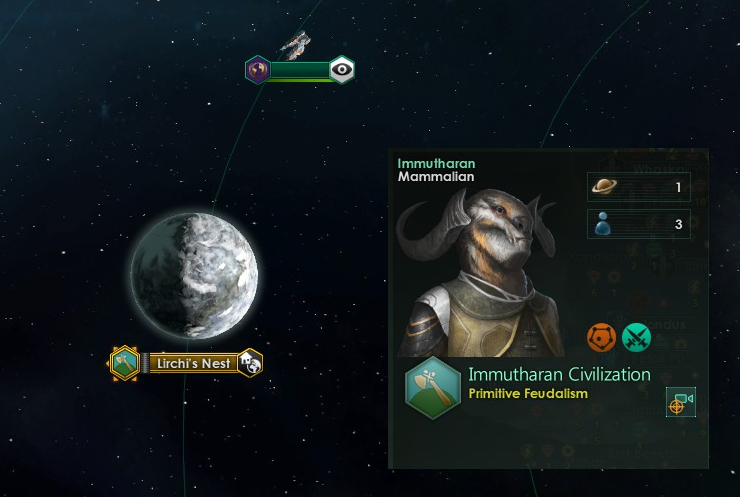
A bronze-age civilization of primitive Mammalians on the arctic world of Nihal III, known by its natives as "Lirchi's Nest."
While exploring the Nihal system near the Human - Uri border, Dr. Sant Mikael's research vessel uncovered something remarkable -- a primitive civilization of horned mammallians at a very early stage of societal development. The beings lacked even basic technology that to humans would be a century old; Dr. Sant Mikael sought permission to construct an observation post over the planet in order to study this species from a distance. These mammalian creatures -- the Immutharan, as they referred to themselves -- were in what appeared to be an early medieval period, not even past a bronze-age equivalent of technological development. President Volkov ordered a strict program of hands-off observation, conducting studies without revealing their nature to the creatures. Dr Sant Mikael chose, however, to disregard these orders, quietly orchestrating the abduction of several Immutharan warriors and scholars, whom he alternately interrogated, dissected, and contained for observation. Cleverly disguising the means by which he came by his findings, the Breton scientists' crew aboard the observation post sent a continuing stream of valuable research back toward Earth.
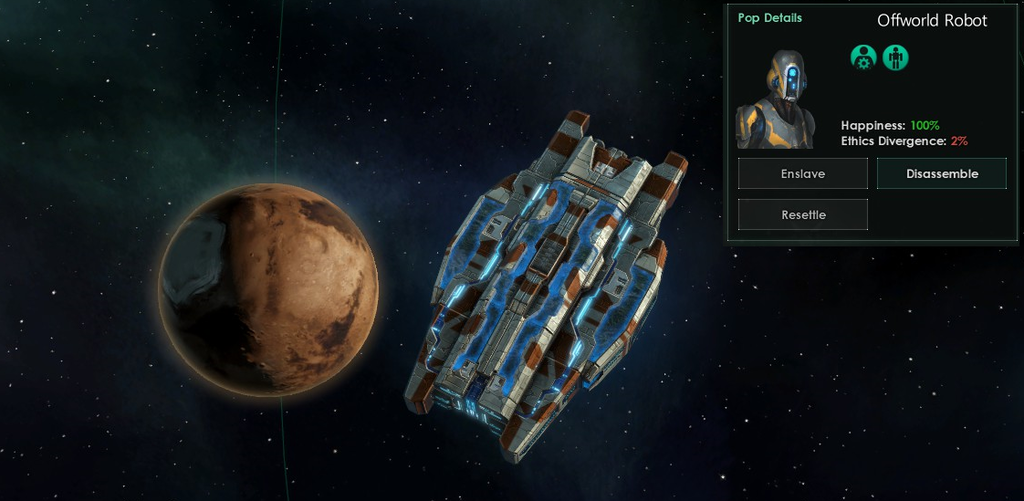
Automated workers are used to found a purely industrial "colony" on Mars.
In 2222, early in his second term, President Volkov announced his plans to begin a colonization mission to Mars. The planet was barren and not properly habitable to humans, but its colonization was pushed for by several interested mining companies on Earth. Taking cues from the Karabnar, leading robotics experts from Japan and France developed humanity's first robotic workers, which were first tested on the surface of the colony on Sant Mikael. When they were deemed acceptable for general excavation, a several units of automated worker robots were commissioned and sent to Mars aboard the CCS Ironbreaker, where they were deposited on the surface to begin constructing a broad network of mining stations. According to the plan laid out by their industrialist sponsors, the surface of Mars would eventually be covered all around by a massive excavation project, bringing large quantities of mineral resources into the coffers of their sponsors and the ENC's tribute fund.
Border Friction and Best Friends
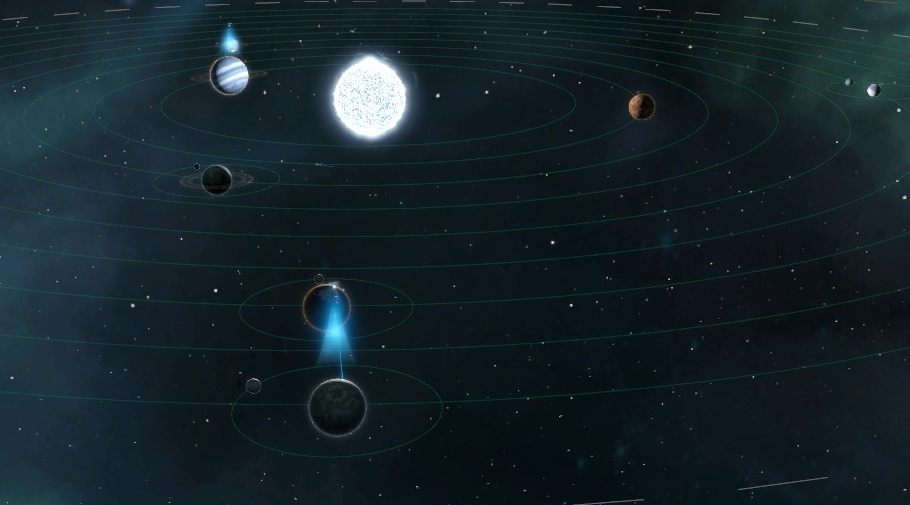
The energy-rich Rimborth system, sought by both the Earth Naval Coalition and the Uri Dominion.
The Earth Naval Coalition never enjoyed positive relationships with the Uri Dominion. Their neighbors to the south were confrontational, abrasive, and worryingly warlike. In the mid-2220's, they declared a war of aggression against the Genoggian Kingdom, which lasted well over five years. In 2228 AD, the relations between the two star nations worsened when Human and Uri science vessels arrived almost simultaneously in the Rimborth system, which contained a wealth of energy and scientific materials. As the rival vessels circled each other, the ENC dispatched a construction ship to erect a lightly-militarized Frontier Outpost orbiting the star, laying a diplomatic claim on the system as part of Coalition territory. The Uri bristled as this move, vocally denouncing the ENC for its move to expand its borders at the expense of the Dominion's agenda.
The aggressive tone of the Uri's denunciation worried a great many back home on earth, who feared the violent species might turn from its conquest of the Genoggians and come for the Humans instead. A hastily-passed UN initiative oversaw the construction of heavily-armed defense fortresses in orbit around Earth to ward off any potential attacks, and several prominent terrestrial leaders pushed Volkov to expand the size and power of the Coalition fleet as a preventative measure against the Uri. Volkov urged caution, and when the Karabnar Star Polity approached him offering to enter into an alliance, he accepted quickly. The alliance of the Humans and Karabnar, Volkov argued, would certainly prevent the Uri from making any aggressive moves, lest they face the combined strength of two different nations. This appeared some, but not others; when it came time for the third ENC presidential election in 2230 AD, Volkov found a rival in Christina Hunter, who ran on a pro-war platform promising to strike preemptively against the Dominion. Volkov ran his campaign on the opposite grounds, arguing for the formation of a strong defensive coalition to deter war while continue to expand peacefully.
The debate leading up to the 2230 election proved that a very different page in history had been turned. The first two elections had dealt more with priorities for research and exploration; now, for the first time, candidates were debating interstellar politics and diplomacy, navigating through alliances and rivalries and the possibility of armed conflict. Any future leader of the Earth Naval Coalition would no longer be a simple leader of an Expedition; the ENC President would now have to deal with 23rd century astropolitics.
2220 - 2230 AD: Continuing to grow while uncovering new allies and rivals
Volkov's Agenda

Alexei Volkov earned a second term as ENC President in the election of 2220.
Alexei Volkov's decade at the helm of the Earth Naval Coalition was a promising one that saw the colonization of two foreign worlds and the establishment of communication with multiple interstellar alien civilizations. In 2220 AD, the UN General Assembly elected him to a second term, extending his agenda for another ten years. With the election secured, Volkov continued to focus on building a network of continually exploitable resources and fostering contact with other species. In many ways, his second term was much like the first -- the ENC continued its bold journey to expand its interstellar frontiers.

A bronze-age civilization of primitive Mammalians on the arctic world of Nihal III, known by its natives as "Lirchi's Nest."
While exploring the Nihal system near the Human - Uri border, Dr. Sant Mikael's research vessel uncovered something remarkable -- a primitive civilization of horned mammallians at a very early stage of societal development. The beings lacked even basic technology that to humans would be a century old; Dr. Sant Mikael sought permission to construct an observation post over the planet in order to study this species from a distance. These mammalian creatures -- the Immutharan, as they referred to themselves -- were in what appeared to be an early medieval period, not even past a bronze-age equivalent of technological development. President Volkov ordered a strict program of hands-off observation, conducting studies without revealing their nature to the creatures. Dr Sant Mikael chose, however, to disregard these orders, quietly orchestrating the abduction of several Immutharan warriors and scholars, whom he alternately interrogated, dissected, and contained for observation. Cleverly disguising the means by which he came by his findings, the Breton scientists' crew aboard the observation post sent a continuing stream of valuable research back toward Earth.

Automated workers are used to found a purely industrial "colony" on Mars.
In 2222, early in his second term, President Volkov announced his plans to begin a colonization mission to Mars. The planet was barren and not properly habitable to humans, but its colonization was pushed for by several interested mining companies on Earth. Taking cues from the Karabnar, leading robotics experts from Japan and France developed humanity's first robotic workers, which were first tested on the surface of the colony on Sant Mikael. When they were deemed acceptable for general excavation, a several units of automated worker robots were commissioned and sent to Mars aboard the CCS Ironbreaker, where they were deposited on the surface to begin constructing a broad network of mining stations. According to the plan laid out by their industrialist sponsors, the surface of Mars would eventually be covered all around by a massive excavation project, bringing large quantities of mineral resources into the coffers of their sponsors and the ENC's tribute fund.
Border Friction and Best Friends

The energy-rich Rimborth system, sought by both the Earth Naval Coalition and the Uri Dominion.
The Earth Naval Coalition never enjoyed positive relationships with the Uri Dominion. Their neighbors to the south were confrontational, abrasive, and worryingly warlike. In the mid-2220's, they declared a war of aggression against the Genoggian Kingdom, which lasted well over five years. In 2228 AD, the relations between the two star nations worsened when Human and Uri science vessels arrived almost simultaneously in the Rimborth system, which contained a wealth of energy and scientific materials. As the rival vessels circled each other, the ENC dispatched a construction ship to erect a lightly-militarized Frontier Outpost orbiting the star, laying a diplomatic claim on the system as part of Coalition territory. The Uri bristled as this move, vocally denouncing the ENC for its move to expand its borders at the expense of the Dominion's agenda.
The aggressive tone of the Uri's denunciation worried a great many back home on earth, who feared the violent species might turn from its conquest of the Genoggians and come for the Humans instead. A hastily-passed UN initiative oversaw the construction of heavily-armed defense fortresses in orbit around Earth to ward off any potential attacks, and several prominent terrestrial leaders pushed Volkov to expand the size and power of the Coalition fleet as a preventative measure against the Uri. Volkov urged caution, and when the Karabnar Star Polity approached him offering to enter into an alliance, he accepted quickly. The alliance of the Humans and Karabnar, Volkov argued, would certainly prevent the Uri from making any aggressive moves, lest they face the combined strength of two different nations. This appeared some, but not others; when it came time for the third ENC presidential election in 2230 AD, Volkov found a rival in Christina Hunter, who ran on a pro-war platform promising to strike preemptively against the Dominion. Volkov ran his campaign on the opposite grounds, arguing for the formation of a strong defensive coalition to deter war while continue to expand peacefully.
The debate leading up to the 2230 election proved that a very different page in history had been turned. The first two elections had dealt more with priorities for research and exploration; now, for the first time, candidates were debating interstellar politics and diplomacy, navigating through alliances and rivalries and the possibility of armed conflict. Any future leader of the Earth Naval Coalition would no longer be a simple leader of an Expedition; the ENC President would now have to deal with 23rd century astropolitics.
ENC Contact Briefing 2nd Edition

Summary Report on Sentient Species Encountered in Galactic Space
January 4, 2229 AD
Compiled for briefing of President Volkov and ENC Executive Council
By Dr. Ludwig Di Savoia, Chief of Social Research, ENC Headquarters
Introduction
When I first published this report nine years ago, we had encountered four advanced civilizations of similar technological ability to ours. I prepared a thorough report for the briefing of the President and the Council in order to provide valuable context for their decisions. In that time, we have granted immigration rights to the Karabnar people, and entered into an alliance with their government. The Uri Dominion have proved to be dangerous rivals, with whom I fear we may find ourselves at war, depending on the results of next year's election.
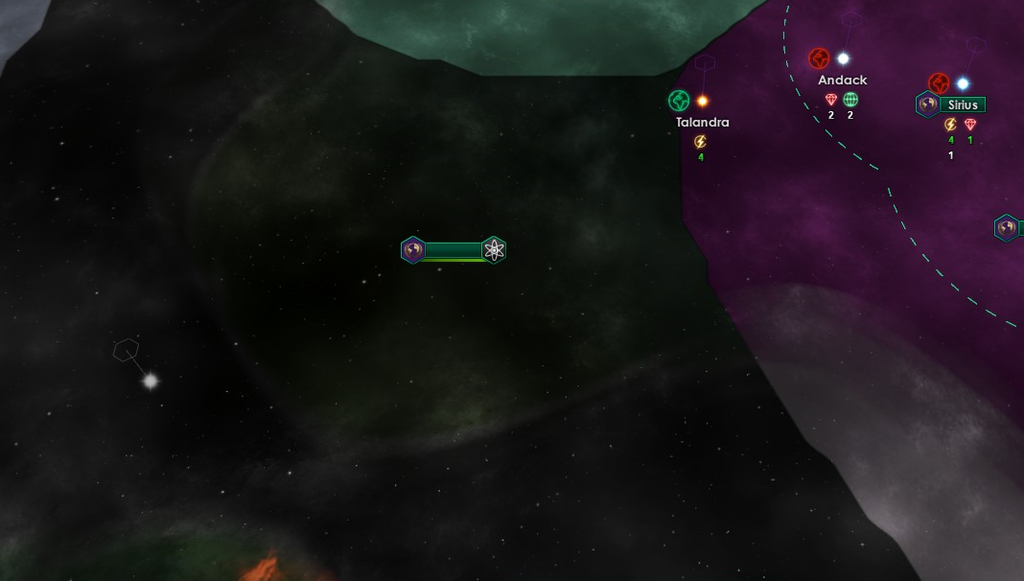
Since then, the development of the second-generation Gireaux Drive has advanced both the speed and the potential range of our warp travel. This has allowed our science vessels, which were previously prevented from exploring further into the galaxy by political borders, to warp across the "dead space" between our own spiral arm and the one adjacent to us, so that our survey can continue in alternate directions. As a result, we have now encountered multiple additional species, many of whom appear significantly more powerful or more advanced than our own people. In light of the many decisions which await us in the coming years, I have been asked to compile an addition to my previous report, chronicling these newest interstellar contacts.
Third Arm Species
1. The Genoggian Kingdom
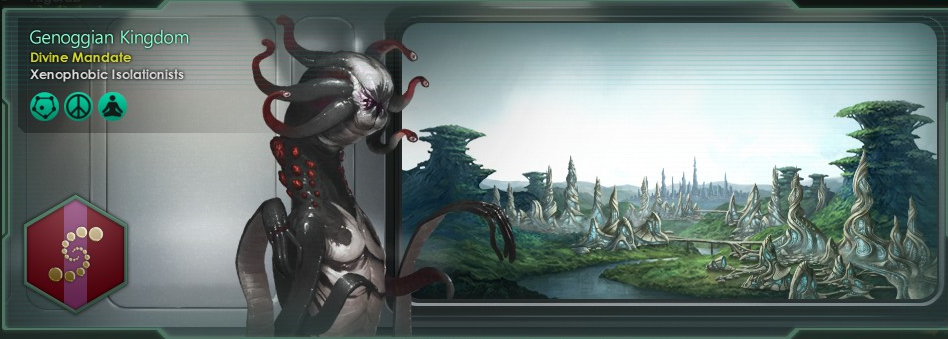
The Genoggians are yet another Molluscoid species, with which this region of the galaxy appears heavily populated. They prefer to keep to themselves, avoiding interstellar politics and preferring to remain strictly among their own kind. Intelligent but wary, they possess keen minds which they prefer to use to avoid conflict. They tend toward warm, tropical worlds, and their society appears based on nonviolent spiritual principles.
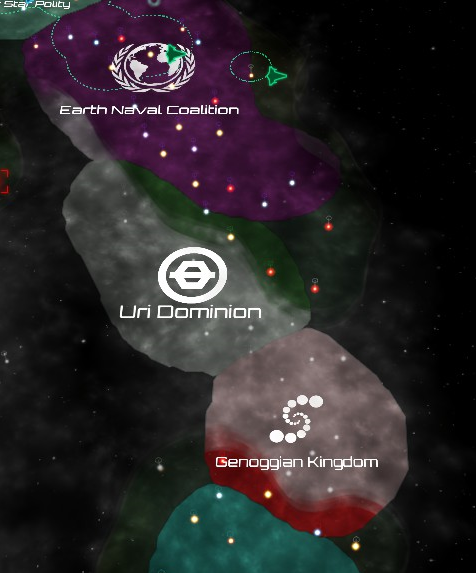
Unfortunately, they are located along the southern border of the Uri Dominion, with whom they are currently fighting a losing war. By my estimation, the Genoggian Kingdom will be overrun in the very near future by the militarily superior Uri. Diplomatic overtures with the Kingdom will only prove useful if they continue to survive as a state -- something I am inclined to say is highly unlikely.
2. The Beldross Galactic Hierarchy
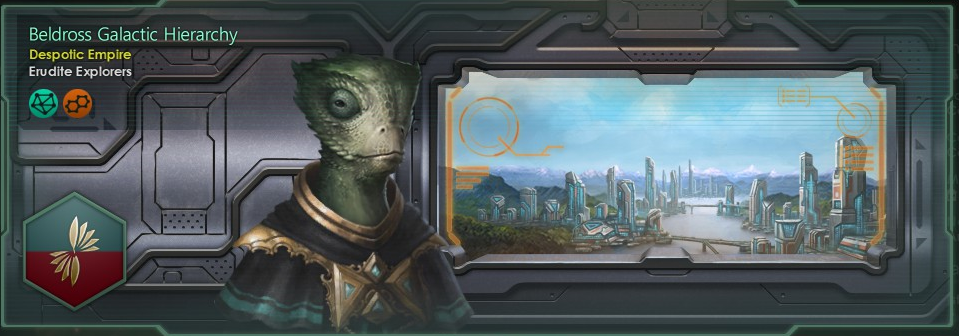
The Beldross are a curious species, with awkward and often offensive mannerisms which have made their social interaction with other peoples difficult, to say the least. These Reptilian creatures dwell on mild continental worlds, and are the first non-Molluscoid species we have discovered thus far. They seem to take well to their endeavors, possessing a natural talent to succeed at most things. They are heavily devoted to exploring the stars and gaining information, and despite their often repuslive mannerisms, they are very open and eager to establish contact with other species. They rule according to a simple despotic model with strong central leadership.
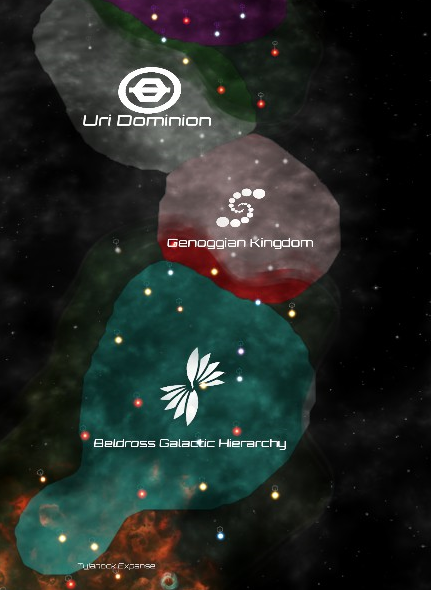
The Beldross are located to the south of the Genoggian Kingdom, and are at the southernmost edge of the star systems we are presently aware of. They have colonized five planets in addition to their homeworld, putting them roughly on par with the Mathin in terms of size. They have established an embassy in Uri space, and have declared the Genoggians as their rivals -- this only leads to my suspicion that the Genoggian Kingdom will soon cease to exist.
Second Arm Species
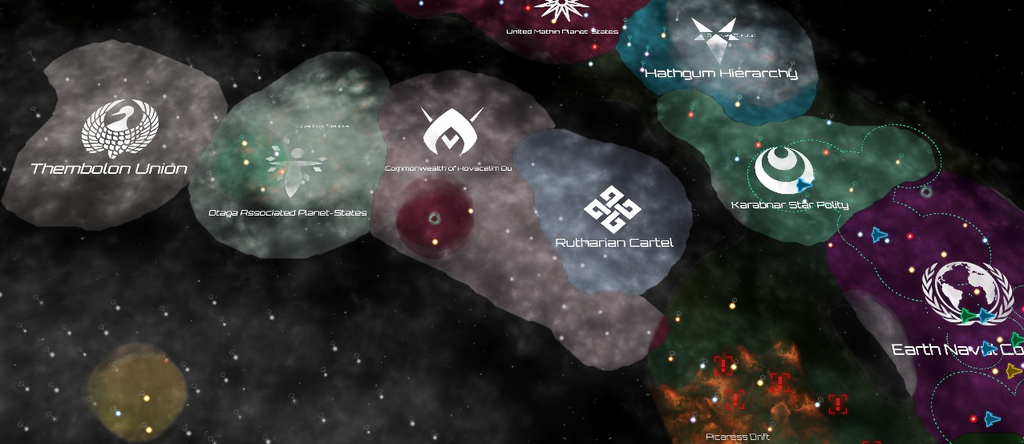
If we begin counting the origin of each arm moving clockwise from the Galactic North, our Earth is located in the third arm of our galaxy. The advancements in warp technology led to the second-generation Gireaux Drive, and marked our first expeditions into the second arm. Here, we uncovered several additional alien civilizations, three of which we believe to be substantially superior in technology and strength to the ENC and the other third arm species.
1. The Rutherian Cartel
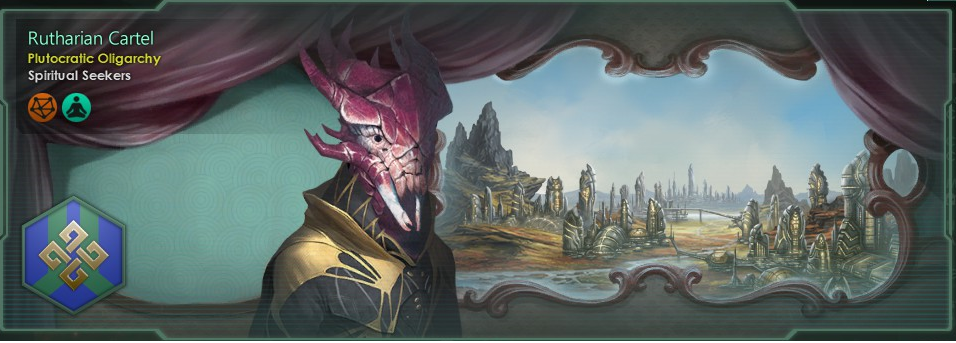
Closest to us is the small Rutharian Cartel, which we believe to be relatively on equal terms with the space empires of the third arm. They are a highly spiritual people native to arid climates, and they are led by a small council of their most influential people, as dictated by wealth and spiritual influence. The Rutharians are nomadic hunter-gatherers who crave contact and interaction with foreign species, done so in a spirit of goodwill from the place of their spiritualist philosophy. They have proven friendly to us thus far, and might prove to be useful comrades in the future. They inhabit a total of four worlds on the second arm, but are nestled precariously against the borders of the much larger Commonwealth of Hovacelim Bu, by whom they are quickly becoming encircled.
2. The Commonwealth of Hovacelim Bu
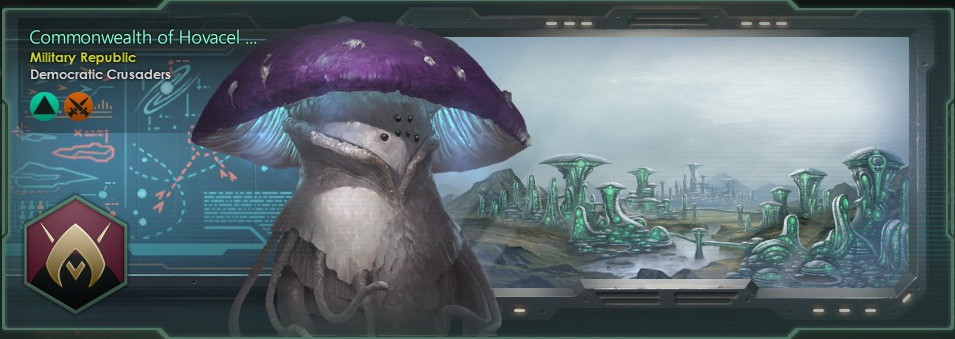
The Celimy are unlike any sentient species I have ever observed. They are a species of large Fungoids, with thick bodies bearing multiple eyes and many long, tendril-like tenticle arms. Their heads are framed by a mushroom-like dome, the interior of which appears bioluminescent. Their manner of movement and speaking are quite foreign to me -- if I might be so bold, I find them rather unsettling. These mushroom-people inhabit frozen tundra worlds, and are highly talented and quick learners.
The Celimy are, by my estimation, clearly the most dominant species in known space. My team estimates their population at somewhere around 61 units, while most species are still numbering in the range of 30. Their empire spans an impressive ten worlds, also the largest out of the known nations we have encountered. We estimate that their military strength and technology are of a higher order than our own, and I strongly caution against provoking them.
In terms of ethics and personality, the Commonwealth is not entirely unlike our own philosophy. They are individualist and value personal liberty, but they are also fanatically dedicated to military buildup; one "ambassador" of the Fungoids informed me that they see it as their mission to spread democratic ideals through the galaxy, by force if necessary. Thankfully, I believe that our present system of government is amenable to them, and so long as we avoid taking actions that could be interpreted as hostile toward them or their allies, I believe we need not fear these Celimy.
3. The Otaga Associated Planet-States
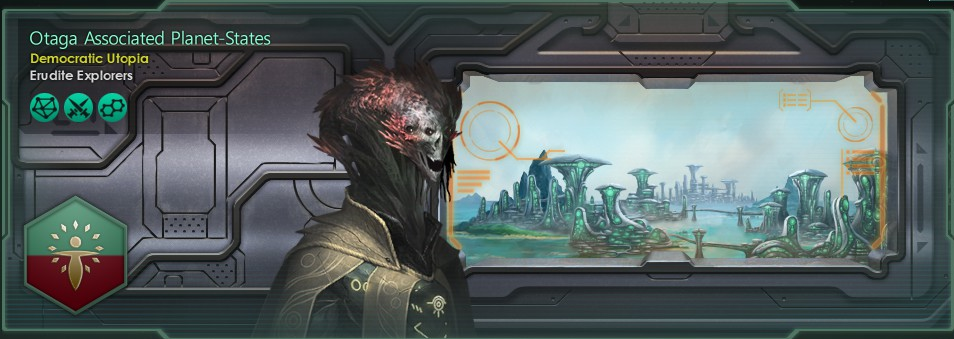
To the west of the Commonwealth of Hovacelim Bu is the Otaga Associated Planet-States, a polity half the size of its neighbor, but still seemingly formidable if our estimations of their strength might be trusted. Also Fungoid in nature, the Otaga appear to have a vaguely humanoid skeletal face at the front of their "heads," and may also have hidden gils as evidenced by their preference for oceanic planets. Skilled researchers in every field but specializing in engineering, these creatures have developed an advanced form of liberal government that we may describe as a "Democratic Utopia," refining liberty and responsibility to a sophisticated point.
Materialistic, militaristic, and xenophilic, their ethics are similarly attuned to ours much as are those of the Celimy. I find it odd that two neighboring Fungoid species share such a similar focus on personal liberty; truly, the depths of space fascinate me. Still, given their distance and the fact that there are multiple intervening interstellar states between us, I do not predict conflict with the Otaga anytime soon.
4. The Thembolon Union
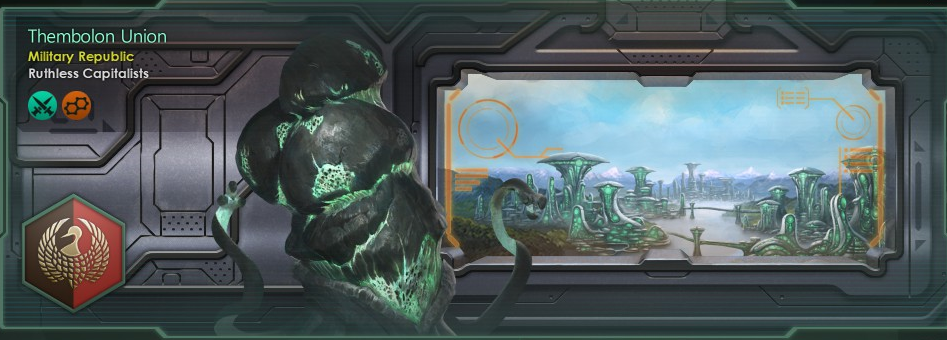
The third Fungoid species in a row, the Thembolon are rapid-breeding creatures with an almost entirely fungal appearance, lacking anything in the way of a relatable appearance. Highly materialistic, the Thembolon are obsessed with economy, manufacturing, and profit. The energy credit is the highest God for the Thembolon, and they agreed to exchange star charts only after we offered a small sum of cash to sweeten the deal. They control seven worlds and are well-populated, and like their neighbors, we estimate that their strength significantly exceeds our own. Distance is a major factor here, though, and our interaction is likely to be minimal for some time.
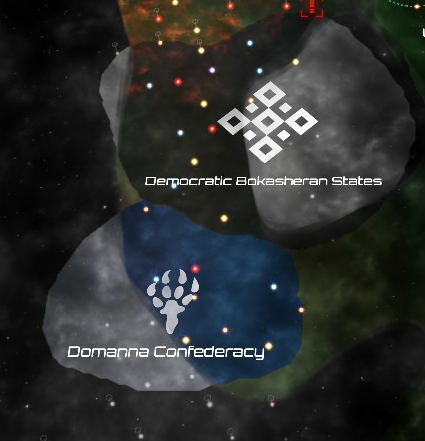
5. The Democratic Bokasheran States
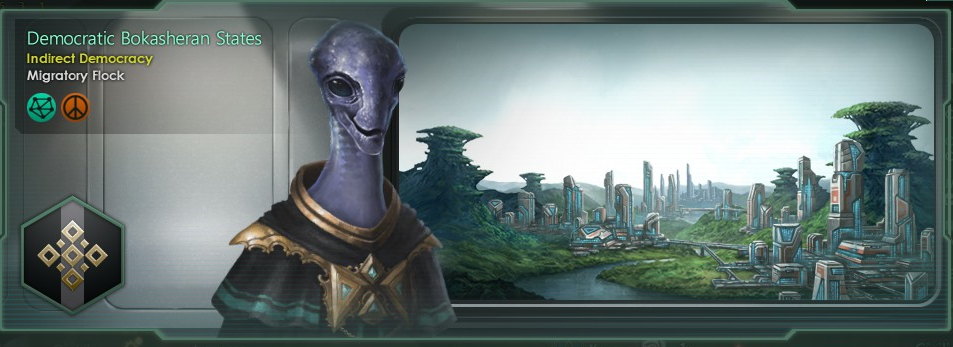
These Reptilians are prolific travelers, and go to great lengths to send their people out to journey to other states and planets. There was a strong push to allow Bokasheran immigration into ENC territory, but their fanatical nonviolence led to concerns that our military campaigns might cause unrest and civil discord. Accordingly, the proposal was declined. The Bokasheran States operate on a democratic system, and, owing to their nomadic tendencies, they are excellent sociologists and are well advanced in programs of social engineering and habitation.
The Bokasherans are located only a short jump across the arms from us, and will likely prefer to maintain positive relations with us. In light of their pacifism, however, I believe there would be little for us to gain by making them one of our closer allies.
6. The Domanna Confedracy
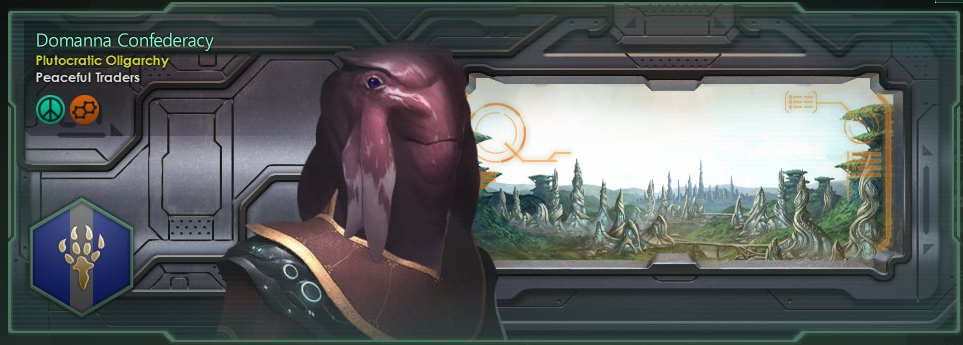
The Domanna are peaceful economics, who prefer to broker and trade rather than to subjugate or fight. Despite their non-threatening personality, the presence of the Domanna is rather unbearable; they are slow-moving, lethargic creatures with an awful, repugnant smell that makes sharing a room with them extremely unpleasant. They control a small region of space, but inhabit 8 worlds, making them a small but dense political body. Like the Bokasherans to their north, they would prefer interaction over warfare, and I do not believe we can expect immediate conflict.

Summary Report on Sentient Species Encountered in Galactic Space
January 4, 2229 AD
Compiled for briefing of President Volkov and ENC Executive Council
By Dr. Ludwig Di Savoia, Chief of Social Research, ENC Headquarters
Introduction
When I first published this report nine years ago, we had encountered four advanced civilizations of similar technological ability to ours. I prepared a thorough report for the briefing of the President and the Council in order to provide valuable context for their decisions. In that time, we have granted immigration rights to the Karabnar people, and entered into an alliance with their government. The Uri Dominion have proved to be dangerous rivals, with whom I fear we may find ourselves at war, depending on the results of next year's election.

Since then, the development of the second-generation Gireaux Drive has advanced both the speed and the potential range of our warp travel. This has allowed our science vessels, which were previously prevented from exploring further into the galaxy by political borders, to warp across the "dead space" between our own spiral arm and the one adjacent to us, so that our survey can continue in alternate directions. As a result, we have now encountered multiple additional species, many of whom appear significantly more powerful or more advanced than our own people. In light of the many decisions which await us in the coming years, I have been asked to compile an addition to my previous report, chronicling these newest interstellar contacts.
Third Arm Species
1. The Genoggian Kingdom

The Genoggians are yet another Molluscoid species, with which this region of the galaxy appears heavily populated. They prefer to keep to themselves, avoiding interstellar politics and preferring to remain strictly among their own kind. Intelligent but wary, they possess keen minds which they prefer to use to avoid conflict. They tend toward warm, tropical worlds, and their society appears based on nonviolent spiritual principles.

Unfortunately, they are located along the southern border of the Uri Dominion, with whom they are currently fighting a losing war. By my estimation, the Genoggian Kingdom will be overrun in the very near future by the militarily superior Uri. Diplomatic overtures with the Kingdom will only prove useful if they continue to survive as a state -- something I am inclined to say is highly unlikely.
2. The Beldross Galactic Hierarchy

The Beldross are a curious species, with awkward and often offensive mannerisms which have made their social interaction with other peoples difficult, to say the least. These Reptilian creatures dwell on mild continental worlds, and are the first non-Molluscoid species we have discovered thus far. They seem to take well to their endeavors, possessing a natural talent to succeed at most things. They are heavily devoted to exploring the stars and gaining information, and despite their often repuslive mannerisms, they are very open and eager to establish contact with other species. They rule according to a simple despotic model with strong central leadership.

The Beldross are located to the south of the Genoggian Kingdom, and are at the southernmost edge of the star systems we are presently aware of. They have colonized five planets in addition to their homeworld, putting them roughly on par with the Mathin in terms of size. They have established an embassy in Uri space, and have declared the Genoggians as their rivals -- this only leads to my suspicion that the Genoggian Kingdom will soon cease to exist.
Second Arm Species

If we begin counting the origin of each arm moving clockwise from the Galactic North, our Earth is located in the third arm of our galaxy. The advancements in warp technology led to the second-generation Gireaux Drive, and marked our first expeditions into the second arm. Here, we uncovered several additional alien civilizations, three of which we believe to be substantially superior in technology and strength to the ENC and the other third arm species.
1. The Rutherian Cartel

Closest to us is the small Rutharian Cartel, which we believe to be relatively on equal terms with the space empires of the third arm. They are a highly spiritual people native to arid climates, and they are led by a small council of their most influential people, as dictated by wealth and spiritual influence. The Rutharians are nomadic hunter-gatherers who crave contact and interaction with foreign species, done so in a spirit of goodwill from the place of their spiritualist philosophy. They have proven friendly to us thus far, and might prove to be useful comrades in the future. They inhabit a total of four worlds on the second arm, but are nestled precariously against the borders of the much larger Commonwealth of Hovacelim Bu, by whom they are quickly becoming encircled.
2. The Commonwealth of Hovacelim Bu

The Celimy are unlike any sentient species I have ever observed. They are a species of large Fungoids, with thick bodies bearing multiple eyes and many long, tendril-like tenticle arms. Their heads are framed by a mushroom-like dome, the interior of which appears bioluminescent. Their manner of movement and speaking are quite foreign to me -- if I might be so bold, I find them rather unsettling. These mushroom-people inhabit frozen tundra worlds, and are highly talented and quick learners.
The Celimy are, by my estimation, clearly the most dominant species in known space. My team estimates their population at somewhere around 61 units, while most species are still numbering in the range of 30. Their empire spans an impressive ten worlds, also the largest out of the known nations we have encountered. We estimate that their military strength and technology are of a higher order than our own, and I strongly caution against provoking them.
In terms of ethics and personality, the Commonwealth is not entirely unlike our own philosophy. They are individualist and value personal liberty, but they are also fanatically dedicated to military buildup; one "ambassador" of the Fungoids informed me that they see it as their mission to spread democratic ideals through the galaxy, by force if necessary. Thankfully, I believe that our present system of government is amenable to them, and so long as we avoid taking actions that could be interpreted as hostile toward them or their allies, I believe we need not fear these Celimy.
3. The Otaga Associated Planet-States

To the west of the Commonwealth of Hovacelim Bu is the Otaga Associated Planet-States, a polity half the size of its neighbor, but still seemingly formidable if our estimations of their strength might be trusted. Also Fungoid in nature, the Otaga appear to have a vaguely humanoid skeletal face at the front of their "heads," and may also have hidden gils as evidenced by their preference for oceanic planets. Skilled researchers in every field but specializing in engineering, these creatures have developed an advanced form of liberal government that we may describe as a "Democratic Utopia," refining liberty and responsibility to a sophisticated point.
Materialistic, militaristic, and xenophilic, their ethics are similarly attuned to ours much as are those of the Celimy. I find it odd that two neighboring Fungoid species share such a similar focus on personal liberty; truly, the depths of space fascinate me. Still, given their distance and the fact that there are multiple intervening interstellar states between us, I do not predict conflict with the Otaga anytime soon.
4. The Thembolon Union

The third Fungoid species in a row, the Thembolon are rapid-breeding creatures with an almost entirely fungal appearance, lacking anything in the way of a relatable appearance. Highly materialistic, the Thembolon are obsessed with economy, manufacturing, and profit. The energy credit is the highest God for the Thembolon, and they agreed to exchange star charts only after we offered a small sum of cash to sweeten the deal. They control seven worlds and are well-populated, and like their neighbors, we estimate that their strength significantly exceeds our own. Distance is a major factor here, though, and our interaction is likely to be minimal for some time.

5. The Democratic Bokasheran States

These Reptilians are prolific travelers, and go to great lengths to send their people out to journey to other states and planets. There was a strong push to allow Bokasheran immigration into ENC territory, but their fanatical nonviolence led to concerns that our military campaigns might cause unrest and civil discord. Accordingly, the proposal was declined. The Bokasheran States operate on a democratic system, and, owing to their nomadic tendencies, they are excellent sociologists and are well advanced in programs of social engineering and habitation.
The Bokasherans are located only a short jump across the arms from us, and will likely prefer to maintain positive relations with us. In light of their pacifism, however, I believe there would be little for us to gain by making them one of our closer allies.
6. The Domanna Confedracy

The Domanna are peaceful economics, who prefer to broker and trade rather than to subjugate or fight. Despite their non-threatening personality, the presence of the Domanna is rather unbearable; they are slow-moving, lethargic creatures with an awful, repugnant smell that makes sharing a room with them extremely unpleasant. They control a small region of space, but inhabit 8 worlds, making them a small but dense political body. Like the Bokasherans to their north, they would prefer interaction over warfare, and I do not believe we can expect immediate conflict.
I wonder if the Immutharans will eventually be the subject of uplifting. It'd be cool to see humanity do that, although it'd be quite expensive for a medieval society.
There seems to be an awful lots of fungi and molluscoid aliens in your galaxy, not to mention that little of space appears uninhabited. Looks like war is inevitable if you want to expand.
There seems to be an awful lots of fungi and molluscoid aliens in your galaxy, not to mention that little of space appears uninhabited. Looks like war is inevitable if you want to expand.
So many neighbors! I'm starting to think you don't have any Fallen Empires in your game. On a minor note, I'm happy you're making use of robots. Glory to AI!
Blood in the Stars
2230 - 2234 AD: The ENC Navy's First Test
War, Peace, and Politics

Alexei Volkov ran for his third term pushing for peace with the Uri Dominion.
While a variety of topics on diplomacy, research, and policy were discussed by the candidates running for office, the ENC presidential election of 2230 AD was really about one issue: war. The Uri Dominion was in the process of toppling and annexing the Genoggian Kingdom, and there were many within the Coalition and back on Earth who feared that the despotic conquerors would turn north when their job was finished and target Human space. Some people wanted war, some people wanted peace... But everyone wanted a plan.
Alexei Volkov, the incumbent leader, was seeking his third term as President of the Coalition on a platform based on temperance and peace. He argued that the formation of a military alliance with the Karabnar Star Polity under his administration was sufficient to deter the Uri's ambitions. While the Dominion might have challenged the Coalition to a one-on-one war, facing a two-against-one scenario was threatening enough that they would back down. By avoiding the great cost of war, both in terms of resources and lives, Volkov argued that exploration and research could be done more efficiently and in safety.
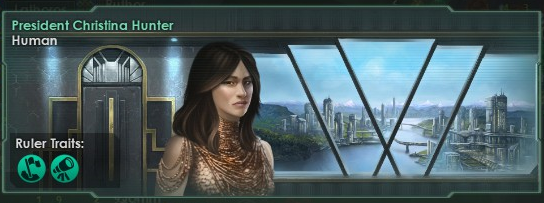
Christina Hunter challenged Volkov by arguing for an invasion of the Uri Dominion.
Volkov enjoyed immense popularity as a two-term President, and the only one of his three challengers who managed to rival him in popularity was Christina Hunter, an aggressive-minded British woman who directly opposed Volkov's platform of nonviolence. Contrary to Volkov, Hunter insisted that the Uri Dominion could not be allowed to expand unmolested if Earth was to remain secure. Inevitably, once they swallowed up enough of their smaller rivals, the Dominion would gain enough strength to challenge the Humans and the Karabnar together, and win. Unless the Uri were defeated, the Coalition would not have room to expand its borders, and would fall behind. The only way to secure the future was to fight and defeat the Dominion.
In the end, Hunter's position proved the more popular won -- but not by much. She was elected President by a margin of only 3%, and her inauguration was a contentious one. She took office, established her cabinet of advisors, and took action almost immediately.
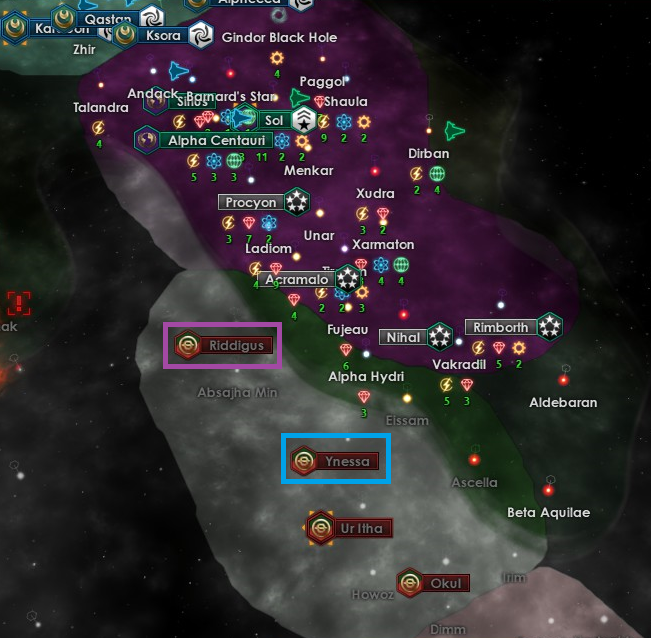
The Human-Karabnar Alliance formally declares war against the Dominion.
In 2231, just over a year after she took office, President Hunter issued a formal declaration of war on behalf of the Earth Naval Coalition and the Karabnar Star Polity. Barely six months after they had conquered the Genoggian Kingdom, the Uri were back at war. The ENC demanded control over the planet Naff'Avm in the Riddigus system; Hunter wanted to bring a new planet into the fold, and with it another system to mine resources from. The KSP took a different avenue, pressing for the liberation of Grah'Jalin, in the Ynessa System, as an independent political state free from Dominion rule.
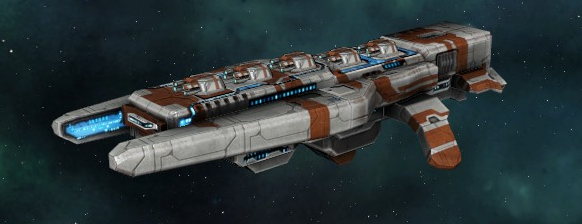
The ENC's Storm-class destroyer, fitted with an array of weaponized lasers.
At the head of the ENC warfleet as the flagship of the invasion was its newest model, the Storm-class destroyer. Larger than the Coalition's corvette designs, the Storm-class mounted five laser weapons reverse-engineered from AI mining drones, and traded in deflector shields for thick, reinforced armor plating. Two vessels -- the CWS London and CWS Miami -- were built for the war and housed Admiral von Boyen and the rest of the fleet's command staff.

The ENC and KSP fleets muster for battle before departing to the front lines.
As the joint war council of the alliance drew up the plan of attack, their fleets gathered and prepared for the battle. As the human fleet mustered outside of ENC Headquarters, fanfare for the invasion gradually built. With a brand new starship deployed in the field and technological advances seeming to come every few years, faith was high on Earth that the ENC fleet would cripple the Uri Dominion and win a swift victory. Preparation took almost a year, but finally, the fleets departed and set their first course toward Naff'Avm.
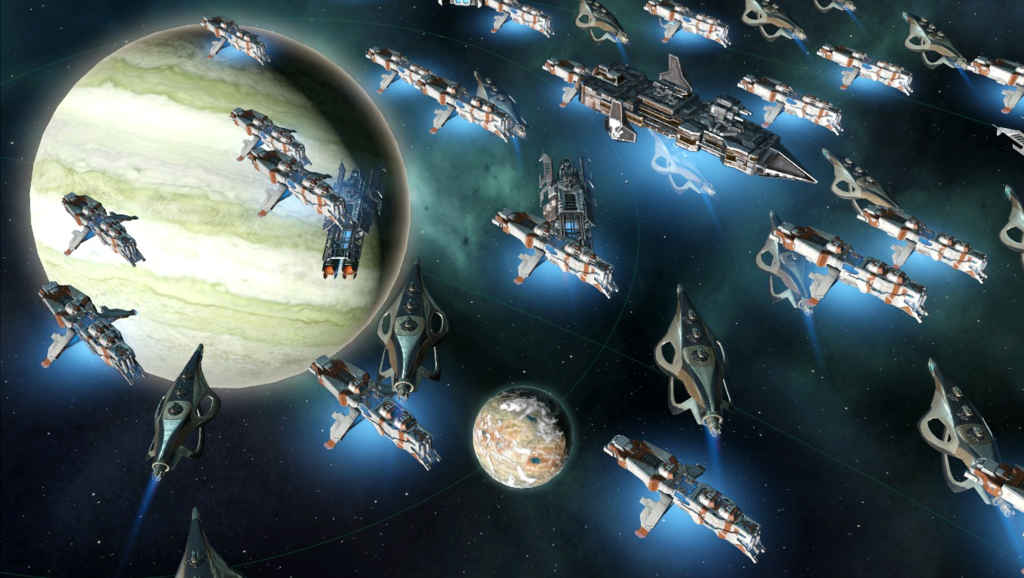
The Human-Karabnar Alliance blockades and bombards the Uri world of Naff'Avm.
Naff'Avm was poorly defended; the Uri fleet was nowhere to be found, and the only installations in the star system were a mining station and a research facility, both of which were destroyed quickly and with almost no opposition. The joint Human-Karabnar invasion fleet took up its position over the arid moon and prepared to make way for the ground assault. For months, lasers and heavy ordnance battered the surface of Naff'Avm, shattering fortresses and decimating the positions that the Uri garrisons were desperately attempting to reinforce. With almost fifty starships raining fire down on the planet, the months-long bombardment gave the attack force a clear advantage. It took two army divisions to storm the surface and put down the resistance; Naff'Avm was declared occupied in May of 2232.
Naff'Avm was the most lightly defended planet in Uri space; the others would prove a more difficult prospect for conquest.
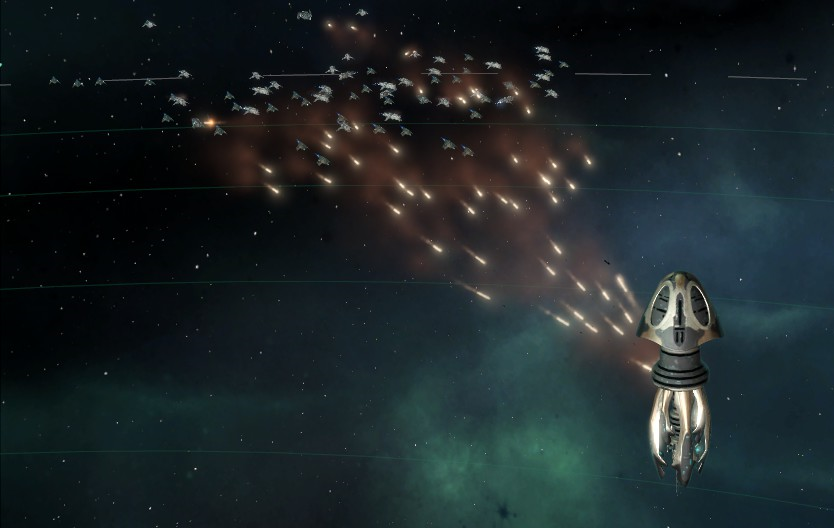
An armored spaceport fights back against the allied invasion.
Grah'Jalin was protected by the defenses of its orbiting spaceport, which was equipped with a variety of light and heavy missiles. A structure of such immense size was well-fortified, and its thick armor was challenging to break through. The Human fleet opened the engagement with a long-range missile bombardment from its Falcon-class corvettes, one of which was destroyed by the spaceport's return fire. As the rest of the fleet closed, the laser-equipped Karabnar ships joined with the Coalition's plasma thrower-equipped, close-range Harpy-class corvettes to deliver the finishing blow. The engagement lasted close to two weeks, but the station was destroyed, and a combination of Human and Karabnar troops occupied the planet after a lengthy orbital strike.
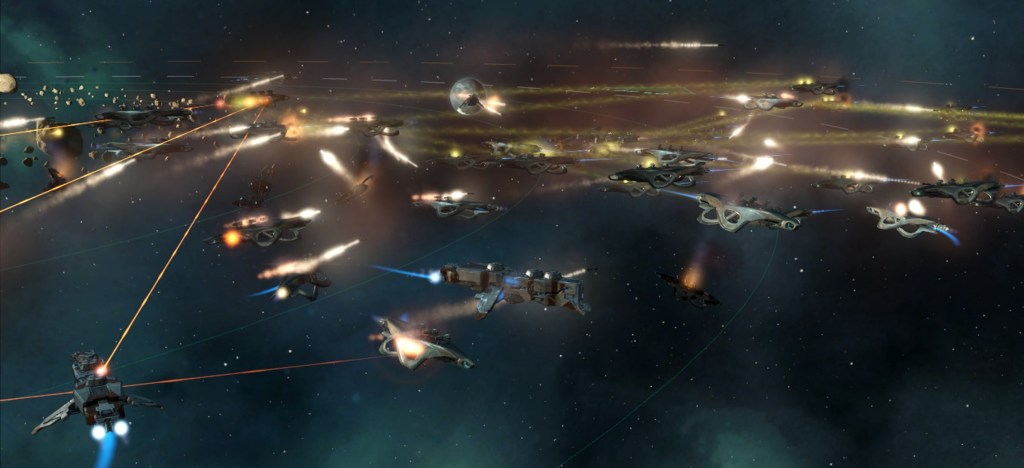
Combined Coalition and Karabnar starships defeat the formidable Uri Dominion fleet.
After the occupation of Grah'Jalin, the Human portion of the fleet jumped ahead to a neighboring system to engage the Uri fleet, which had just jumped in on its way to launch a counterattack. Admiral von Boyen engaged the Uri in a furious battle, bringing all of the Coalition's newest military resources to bear. In the first few days of combat, however, it quickly became clear that the Human fleet was outmatched. The Dominion warfleet boasted superior armor significantly tougher than what the Humans had developed, and their missile-based arsenal was highly effective against the Coalition's largely shield-based defenses. While von Boyen's ships did sink a few Uri vessels, her fleet quickly fell behind and suffered almost 50% casualties before the Karabnar fleet arrived.
Thankfully, the Karabnar's laser weaponry cut through the Uri, and a one-sided battle in favor of the Dominion quickly turned into a rout, as 3/4 of the Dominion fleet was destroyed before the survivors performed an emergency FTL jump out of the system to avoid total annihilation. It was a close call for Admiral von Boyen, but her Karabnar allies ensured that the war ended in victory.
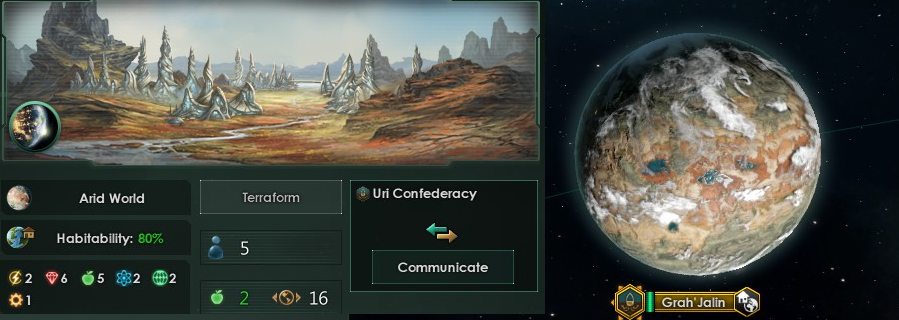
The Uri Confederacy, established at the conclusion of the war according to the Karabnar Star Polity's demands.
On April 4, 2234, the Uri Dominion surrendered and accepted the demands of the Human-Karabnar Alliance. Naff'Avm was surrendered to the rule of the ENC, along with its decidedly unhappy conquered population. Grah'Jalin was handed over to a separatist faction who claimed the name "Uri Confederacy," establishing a new free government on their homeworld.
The survivors of the ENC fleet -- just less than half of the forces sent to begin the war; returned home to a mixed reaction. On one hand, the victory was much appreciated, and the weakened state of the Uri Dominion put many minds at peace. On the other hand, though, the victory was only made possible by the Karabnar; the Human fleet had been totally outmatched against the Uri and would have been destroyed in single combat. Mankind still had much to learn about competing on an interstellar stage.
Still, the war was over, peace had returned, and the ENC could get back to strengthening its own star systems.
2230 - 2234 AD: The ENC Navy's First Test
War, Peace, and Politics

Alexei Volkov ran for his third term pushing for peace with the Uri Dominion.
While a variety of topics on diplomacy, research, and policy were discussed by the candidates running for office, the ENC presidential election of 2230 AD was really about one issue: war. The Uri Dominion was in the process of toppling and annexing the Genoggian Kingdom, and there were many within the Coalition and back on Earth who feared that the despotic conquerors would turn north when their job was finished and target Human space. Some people wanted war, some people wanted peace... But everyone wanted a plan.
Alexei Volkov, the incumbent leader, was seeking his third term as President of the Coalition on a platform based on temperance and peace. He argued that the formation of a military alliance with the Karabnar Star Polity under his administration was sufficient to deter the Uri's ambitions. While the Dominion might have challenged the Coalition to a one-on-one war, facing a two-against-one scenario was threatening enough that they would back down. By avoiding the great cost of war, both in terms of resources and lives, Volkov argued that exploration and research could be done more efficiently and in safety.

Christina Hunter challenged Volkov by arguing for an invasion of the Uri Dominion.
Volkov enjoyed immense popularity as a two-term President, and the only one of his three challengers who managed to rival him in popularity was Christina Hunter, an aggressive-minded British woman who directly opposed Volkov's platform of nonviolence. Contrary to Volkov, Hunter insisted that the Uri Dominion could not be allowed to expand unmolested if Earth was to remain secure. Inevitably, once they swallowed up enough of their smaller rivals, the Dominion would gain enough strength to challenge the Humans and the Karabnar together, and win. Unless the Uri were defeated, the Coalition would not have room to expand its borders, and would fall behind. The only way to secure the future was to fight and defeat the Dominion.
In the end, Hunter's position proved the more popular won -- but not by much. She was elected President by a margin of only 3%, and her inauguration was a contentious one. She took office, established her cabinet of advisors, and took action almost immediately.

The Human-Karabnar Alliance formally declares war against the Dominion.
In 2231, just over a year after she took office, President Hunter issued a formal declaration of war on behalf of the Earth Naval Coalition and the Karabnar Star Polity. Barely six months after they had conquered the Genoggian Kingdom, the Uri were back at war. The ENC demanded control over the planet Naff'Avm in the Riddigus system; Hunter wanted to bring a new planet into the fold, and with it another system to mine resources from. The KSP took a different avenue, pressing for the liberation of Grah'Jalin, in the Ynessa System, as an independent political state free from Dominion rule.

The ENC's Storm-class destroyer, fitted with an array of weaponized lasers.
At the head of the ENC warfleet as the flagship of the invasion was its newest model, the Storm-class destroyer. Larger than the Coalition's corvette designs, the Storm-class mounted five laser weapons reverse-engineered from AI mining drones, and traded in deflector shields for thick, reinforced armor plating. Two vessels -- the CWS London and CWS Miami -- were built for the war and housed Admiral von Boyen and the rest of the fleet's command staff.

The ENC and KSP fleets muster for battle before departing to the front lines.
As the joint war council of the alliance drew up the plan of attack, their fleets gathered and prepared for the battle. As the human fleet mustered outside of ENC Headquarters, fanfare for the invasion gradually built. With a brand new starship deployed in the field and technological advances seeming to come every few years, faith was high on Earth that the ENC fleet would cripple the Uri Dominion and win a swift victory. Preparation took almost a year, but finally, the fleets departed and set their first course toward Naff'Avm.

The Human-Karabnar Alliance blockades and bombards the Uri world of Naff'Avm.
Naff'Avm was poorly defended; the Uri fleet was nowhere to be found, and the only installations in the star system were a mining station and a research facility, both of which were destroyed quickly and with almost no opposition. The joint Human-Karabnar invasion fleet took up its position over the arid moon and prepared to make way for the ground assault. For months, lasers and heavy ordnance battered the surface of Naff'Avm, shattering fortresses and decimating the positions that the Uri garrisons were desperately attempting to reinforce. With almost fifty starships raining fire down on the planet, the months-long bombardment gave the attack force a clear advantage. It took two army divisions to storm the surface and put down the resistance; Naff'Avm was declared occupied in May of 2232.
Naff'Avm was the most lightly defended planet in Uri space; the others would prove a more difficult prospect for conquest.

An armored spaceport fights back against the allied invasion.
Grah'Jalin was protected by the defenses of its orbiting spaceport, which was equipped with a variety of light and heavy missiles. A structure of such immense size was well-fortified, and its thick armor was challenging to break through. The Human fleet opened the engagement with a long-range missile bombardment from its Falcon-class corvettes, one of which was destroyed by the spaceport's return fire. As the rest of the fleet closed, the laser-equipped Karabnar ships joined with the Coalition's plasma thrower-equipped, close-range Harpy-class corvettes to deliver the finishing blow. The engagement lasted close to two weeks, but the station was destroyed, and a combination of Human and Karabnar troops occupied the planet after a lengthy orbital strike.

Combined Coalition and Karabnar starships defeat the formidable Uri Dominion fleet.
After the occupation of Grah'Jalin, the Human portion of the fleet jumped ahead to a neighboring system to engage the Uri fleet, which had just jumped in on its way to launch a counterattack. Admiral von Boyen engaged the Uri in a furious battle, bringing all of the Coalition's newest military resources to bear. In the first few days of combat, however, it quickly became clear that the Human fleet was outmatched. The Dominion warfleet boasted superior armor significantly tougher than what the Humans had developed, and their missile-based arsenal was highly effective against the Coalition's largely shield-based defenses. While von Boyen's ships did sink a few Uri vessels, her fleet quickly fell behind and suffered almost 50% casualties before the Karabnar fleet arrived.
Thankfully, the Karabnar's laser weaponry cut through the Uri, and a one-sided battle in favor of the Dominion quickly turned into a rout, as 3/4 of the Dominion fleet was destroyed before the survivors performed an emergency FTL jump out of the system to avoid total annihilation. It was a close call for Admiral von Boyen, but her Karabnar allies ensured that the war ended in victory.

The Uri Confederacy, established at the conclusion of the war according to the Karabnar Star Polity's demands.
On April 4, 2234, the Uri Dominion surrendered and accepted the demands of the Human-Karabnar Alliance. Naff'Avm was surrendered to the rule of the ENC, along with its decidedly unhappy conquered population. Grah'Jalin was handed over to a separatist faction who claimed the name "Uri Confederacy," establishing a new free government on their homeworld.
The survivors of the ENC fleet -- just less than half of the forces sent to begin the war; returned home to a mixed reaction. On one hand, the victory was much appreciated, and the weakened state of the Uri Dominion put many minds at peace. On the other hand, though, the victory was only made possible by the Karabnar; the Human fleet had been totally outmatched against the Uri and would have been destroyed in single combat. Mankind still had much to learn about competing on an interstellar stage.
Still, the war was over, peace had returned, and the ENC could get back to strengthening its own star systems.
So many neighbors! I'm starting to think you don't have any Fallen Empires in your game. On a minor note, I'm happy you're making use of robots. Glory to AI!
Yes, tons of neighbors... I made the galaxy kind of full XD
Mankind may have had a rough first interstellar war, casualties wise, but I'm confident they can pull through and curb stomp their neighbors into submission.

